I’m now fortunate to own the new Sony FE 200-600mm F5.6-6.3 G lens and have begun my comparison and review with the more expensive Sony FE 100-400 F4.5-5.6 GM lens, a lens that I have owned since it was first launched back in April, 2017.
Sadly one of these lenses will probably need to be sold at some point soon, but which one am I going to let go?
I’m already reasonably certain I know which one already, but before I make the final decision I’m going to compare these two lenses against each other.

Before I get started if you are on Facebook then please do consider joining the Sony Alpha Wildlife Shooters Group that I run. There you’ll find many friendly group members sharing photos shot with both the Sony 100-400 and the 200-600 lenses mounted to a range of different Alpha cameras. You’ll also find lots of helpful tips and tricks.
Table of Contents[Hide][Show]
- Handling
- Field of View
- Color Rendition
Autofocus Test with Frank+−
- Sony a6400 Autofocus Test at 400mm
- Sony a6400 Autofocus Test at 560mm / 600mm
- Sony a7III Autofocus Test at 400mm
- Sony a7III Autofocus Test at 560mm / 600mm
- Sony a7R III Autofocus Test at 400mm
- Sony a7R III Autofocus Test at 560mm / 600mm
- Sony a9 Autofocus Test at 400mm
- Sony a9 Autofocus Test at 560mm / 600mm
- Autofocus Test with Birds in Flight
- Minimum Focus Distance
- Conclusion
- Sony 200-600 Bag Guide
Body Design
Both lenses are very well made from magnesium-alloy and feature rubber gaskets to help keep dust and moisture at bay.
Besides the obvious focal length and aperture differences, the biggest difference is that the 100-400 lens extends when you zoom whilst the 200-600 features a fixed length internal zoom design that does not extend, and therefore the distance between the front element and your subject does not change as you zoom.
Size and Weight
The 100-400 is the lightweight of these two telephoto zooms and weighs in at 1596g (with tripod foot and hood attached). Without extending the zoom it measures 205mm in length, extending the zoom to 400mm takes it to 285mm. The lens has a maximum diameter of 93.9mm.
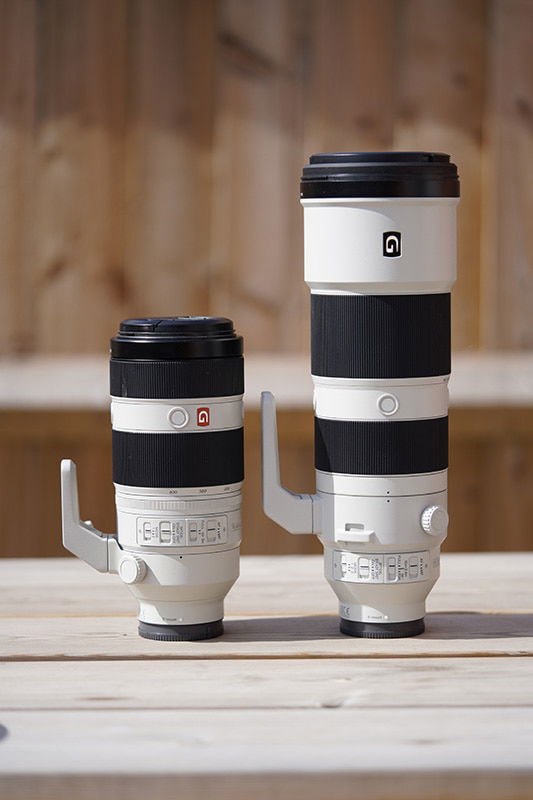
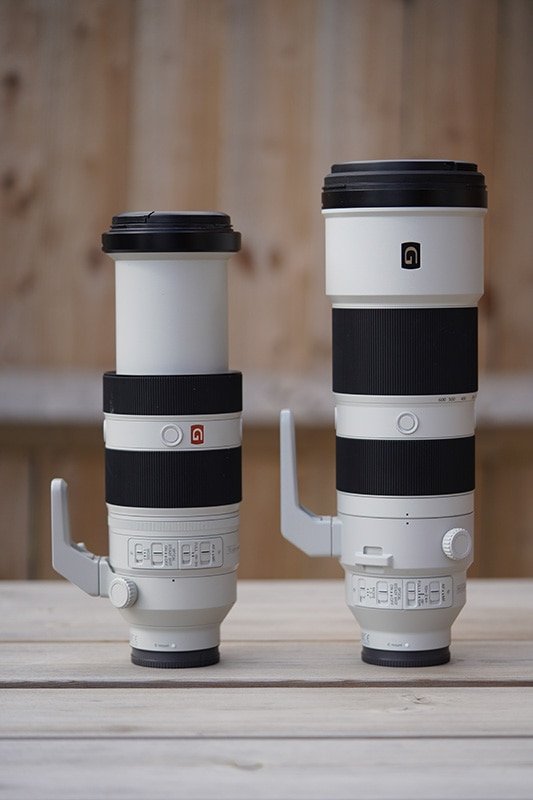
The 200-600 weighs in at 2397g (with tripod foot and hood attached), making it 801g heavier. It measures 318mm in length with a maximum diameter of 111.5mm.
If you decide to add the 1.4x teleconverter to the 100-400 to take the focal length to 560mm then this will add an additional 169g in weight and now the 200-600 is only 632g heavier, it also adds 16mm in length.

Control Buttons
Both lenses include 3 customizable buttons surrounding the barrel towards the end of the lens.
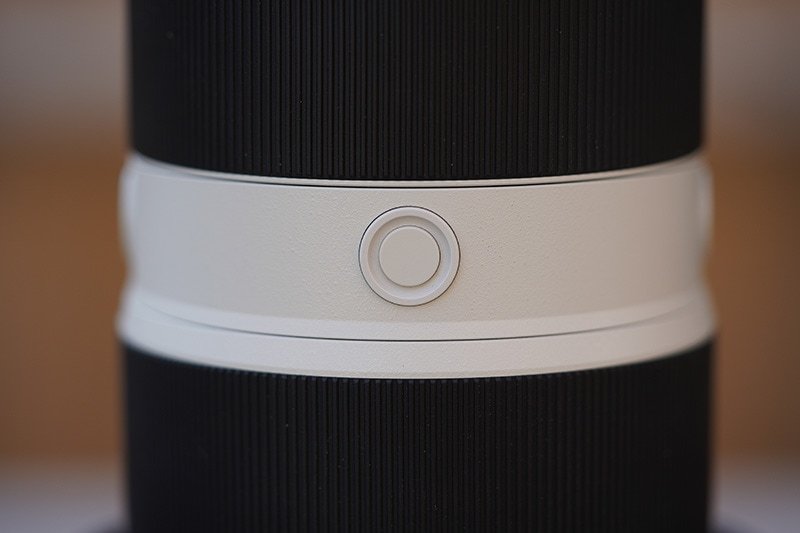
They also include very similar controls but not identical.
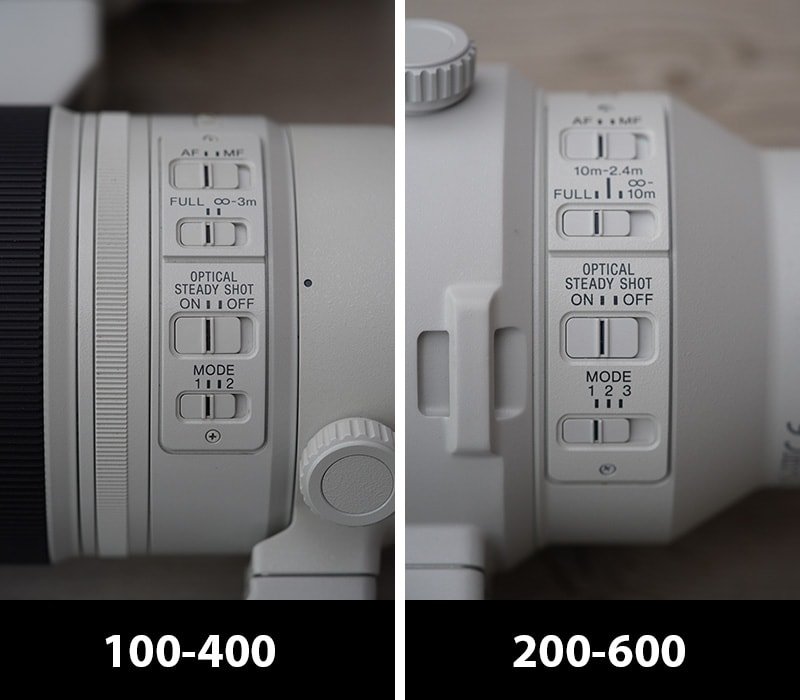
Above you can see the main lens controls and if you look closely you will notice two key differences.
The first is that the 200-600 features 3 focus limiter settings. You can choose between full, 10m-2.4m, or infinity to 10m. The 100-400 has only two focus limiter settings and you can choose between full or infinity to 3m.
The second key difference is that the 200-600 includes an additional OSS (Optical SteadyShot) Mode 3 setting that provides stabilization for tracking and shooting dynamic, unpredictable sports action.
Focal Length, Zoom and Focus Rings
The Sony FE 100-400 GM has a variable aperture of f/4.5 – 5.6 and it jumps to f/5.6 at 164mm, the maximum focal length is 400mm. The Sony FE 200-600mm G also has a variable aperture but this time it’s from f/5.6 – 6.3 and it jumps to f/6.3 at 300mm, the maximum focal length is 600mm.
The 100-400 features a zoom smoothness adjuster that provides mechanical control of zoom ring torque, although even when set to tight you will still get a little zoom creep if you hold the lens pointing towards the ground. The 200-600 does not require such a control since it’s an internal zoom and does not extend.

The zoom ring of the 100-400 is located closest to the camera body and has a throw of around 3.5 inches. The zoom ring of the 200-600 is located furthest away from the camera body and has a short throw of just 2.5 inches, so effectively both zoom and focus rings are reversed on each lens.
The zoom ring of the 200-600 is much smoother and easier to control compared to the 100-400 which has more resistance to it even on the smooth setting.
The focus ring of the 100-400 has very little resistance and if you are manually focusing it’s far too easy to throw out the focus by simply removing your fingers from the ring. Thankfully the 200-600 has more resistance yet is still easy to adjust.
Tripod Collar and Foot
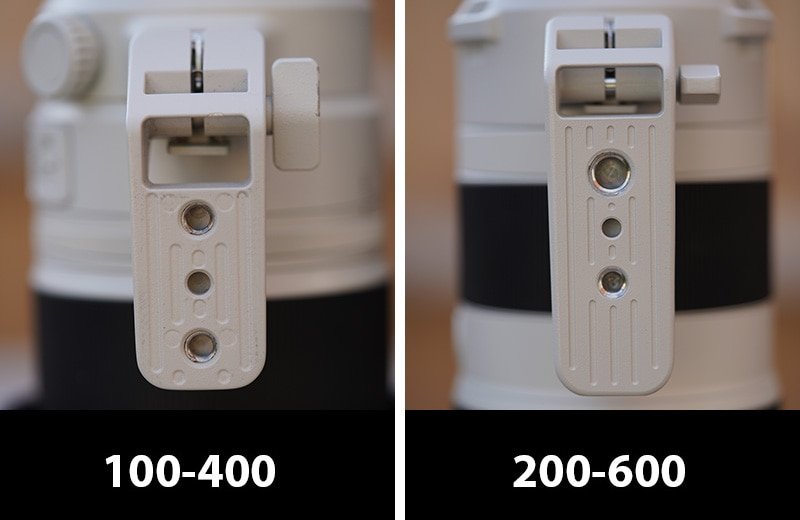
Both lenses include a tripod collar and foot. The 100-400 has two 1/4″-20 screw threads on the foot and the 200-600 has one 1/4″-20 thread and one 3/8″-20 thread.
There’s a chunky release knob on each lens to allow them to rotate within their collars. The collar cannot be removed from either lens but the feet do come off the collar exposing a 1/4″-20 thread on each.

Neither feet include an Arca-Swiss quick release plate which other lenses like the Sigma 60-600 do feature. So if you wish to use the lens on a tripod or gimbal head this leaves you with two options, you can either attach an arca-swiss quick release plate to the foot, or you can replace the entire foot for one that is arca-swiss compatible.
Personally I prefer to replace the original foot with one that is arca-swiss compatible, as quick release plates can come loose and I have in the past left them at home and only realized when I came to mount the lens to my gimbal which is rather frustrating, they also add additional weight.
I’m using the Kirk LP-65 (B&H Photo) for my 100-400 and have also purchased the Kirk LP-68 (B&H Photo) for the 200-600. The foot mounts are different sizes so if you already have the Kirk LP-65 on your 100-400 I’m afraid it won’t fit the 200-600.
There’s also the Really Right Stuff LCF-102 for the 200-600 (B&H Photo). I’ve not used this myself but it goes get very positive reviews.
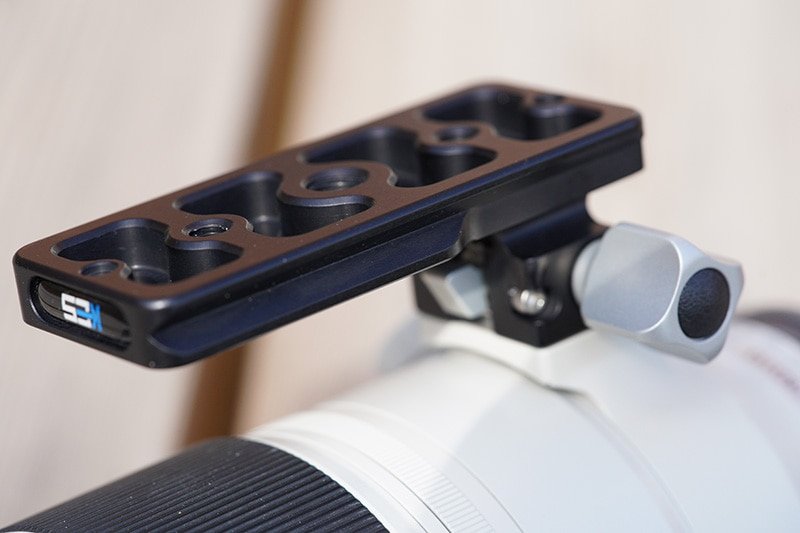
The Kirk LP-65 on the 100-400
Both the LP-65 and LP-68 are also longer and wider than the original Sony feet which makes holding the lens by the foot a lot safer and more comfortable. They also feature a similar tool free release system just like the original Sony feet.
Lens Hoods
The Sony 100-400 includes the ALC-SH151 bayonet style lens hood that features a small hatch to allow you to rotate a circular polarizer without detaching the hood, there’s also a small button to release the hood and there’s a black velvet like lining inside the hood to help reduce reflections.

The Sony 200-600 includes the ALC-SH157 bayonet style hood but unlike the 100-400 this does not include a small hatch or release button, there is also no velvet like lining on the inside just dark plastic.
The 200-600 lens hood should click into place with a nice firm click (as mine does), however some Alpha Shooters appear to have received hoods that are not attaching so firmly and a few have even lost or damaged the hoods as a result. If you do purchase this lens I’d recommend checking that the hood does click firmly into place, if this isn’t the case and you feel like it could easily come loose then I’d recommend returning the lens for a replacement.
Both hoods feature a rubber ring to protect the hood if you stand the lenses upright. Both hoods can also be inverted and attached to the lens to reduce the transport size.
Filter Threads
The Sony 100-400 features a 77mm filter thread whilst the 200-600 has a larger 95mm thread.
Teleconverter Support
Both lenses support the Sony 1.4x (SEL14TC) and 2x (SEL20TC) teleconverters.
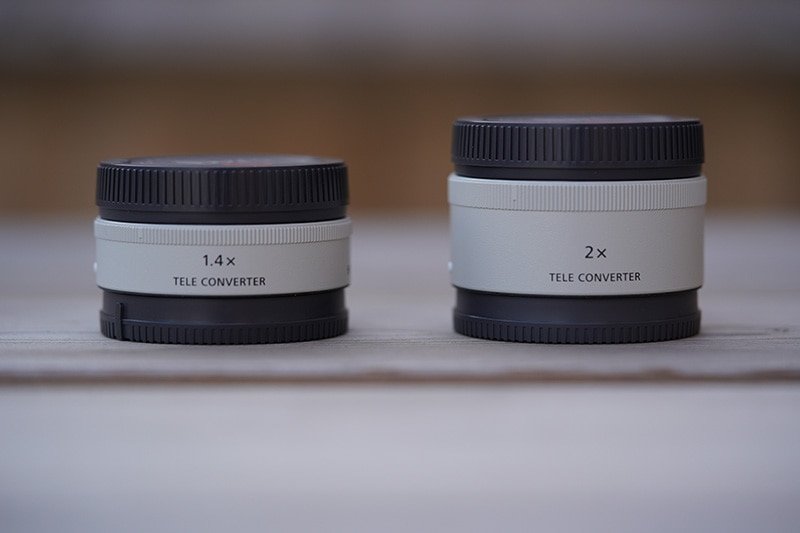
The 1.4x will extend the reach of the 100-400mm to a maximum of 560mm at f/8, and the 200-600mm to a maximum reach of 840mm at f/9. The 2.0x extends the 100-400mm to a maximum of 800mm at f/11 and the 200-600mm to a maximum of 1200mm at f/13.
Handling
The 100-400 is very well balanced even when fully extended at 400mm, the 200-600 on the other-hand seems to carry more of its weight towards the front of the lens making it a little more front heavy.
If you use these lenses side by side you are most definitely going to notice the additional 801 grams that the 200-600 is carrying. Maybe it doesn’t sound like a lot but if you are handholding then you are definitely going to feel the difference and your arms will tire much sooner than they will holding the 100-400.
If you are used to heavy lenses then the 200-600 might seem like a feather to you, but if you are coming from the 100-400 like myself then you will feel the extra weight, especially shooting birds in flight and airshows.
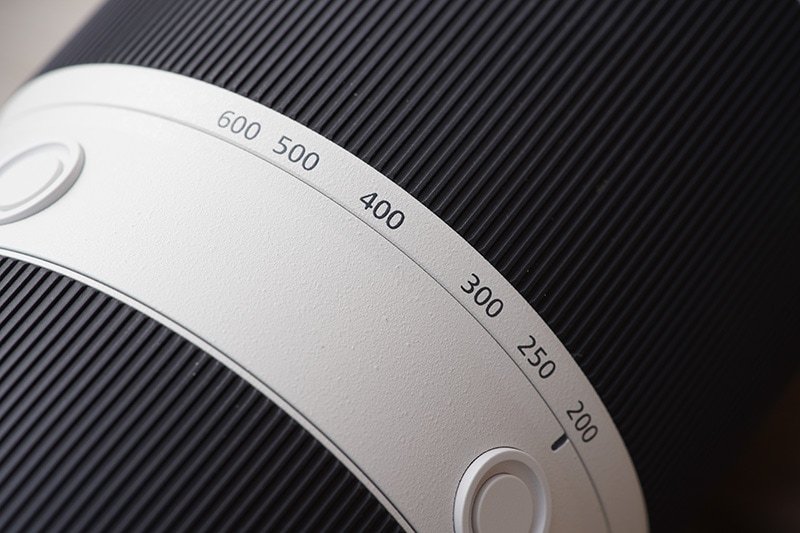
When it comes to zooming the 200-600 wins hands down. The internal zoom doesn’t throw off the balance at all when you zoom in and out, and the short zoom throw of 2.5 inches requires just a twist of the wrist to go from 200mm to 600mm and back again. The zoom action is also very smooth with the perfect amount of resistance.
Zooming on the 100-400 isn’t the most pleasant experience when compared to the 200-600. Even on the smoothest setting there is quite some resistance when shooting skywards which makes it more difficult to achieve a nice smooth zoom action. The zoom throw is also greater at around 3.5 inches and may require you to adjust your grip when zooming from 100-400.
If you are using a gimbal then balancing the 200-600 is a breeze and due to it’s internal zoom design it remains balanced as you zoom in and out. The 100-400 isn’t so gimbal friendly and you’ll need to balance it at each focal length you wish to use it at or simply tighten the gimbal head each time you remove your hands.

Field of View
The Sony FE 100-400 covers a focal range of 100-400mm, whereas the Sony FE 200-600 coverers a focal range of 200-600mm. Here’s a quick field of view comparison for these different focal lengths.
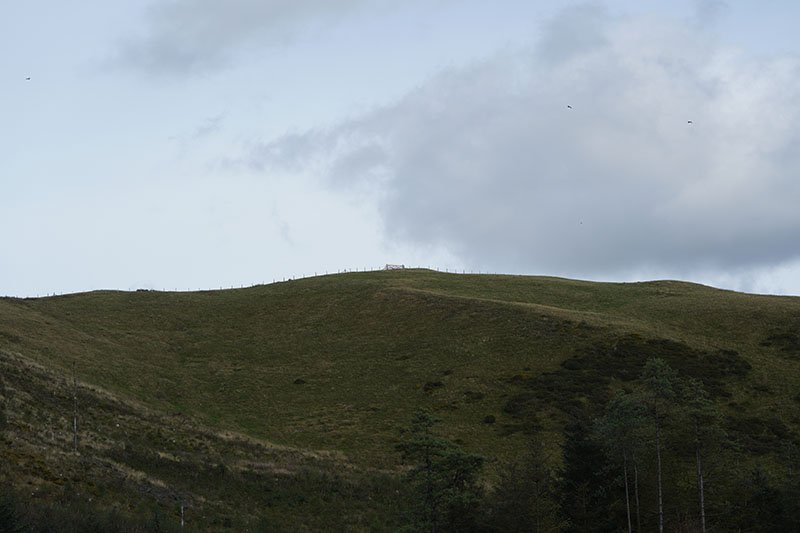
100mm
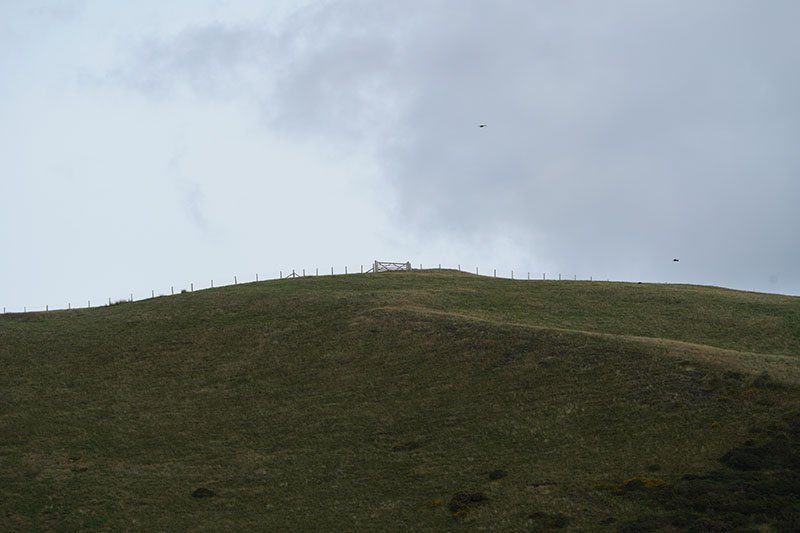
200mm

400mm
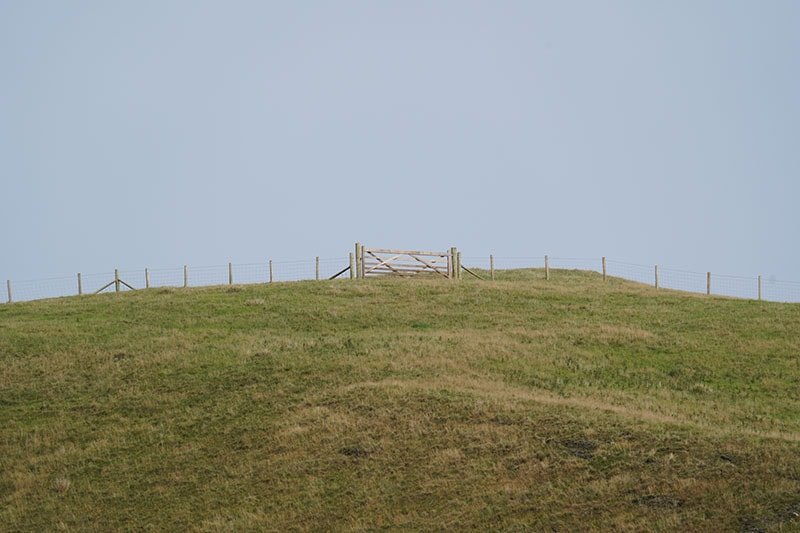
600mm
You can add the 1.4x teleconverter to the 100-400 which takes you to 560mm and gets you close to 600, however you’ll now be at f/8 compared with f/6.3 of the 200-600. Also adding the teleconverter does impact image quality which you will see in the following sharpness tests.
Sharpness Comparison
For these sharpness tests I mainly used my Sony a7R III together with a sturdy tripod. I’ve also added a few shots from my a9.
I turned off stabilization, used the electronic shutter to avoid any shutter shock and triggered the a7R III shutter using the Sony RMT-P1BT remote control. The a9 was set on a 5 second timer.
I also manually focused with the help of focus peaking + focus zoom and took multiple shots whilst micro adjusting the focus, selecting only the sharpest images from each lens to compare.
200mm Comparison 1
The following two images I shot from around 15m away and I focused on Manny the Mammoth’s yellow label. I shot wide open at f/5.6 on both lenses. Hit the links below each image to download the full sized images.
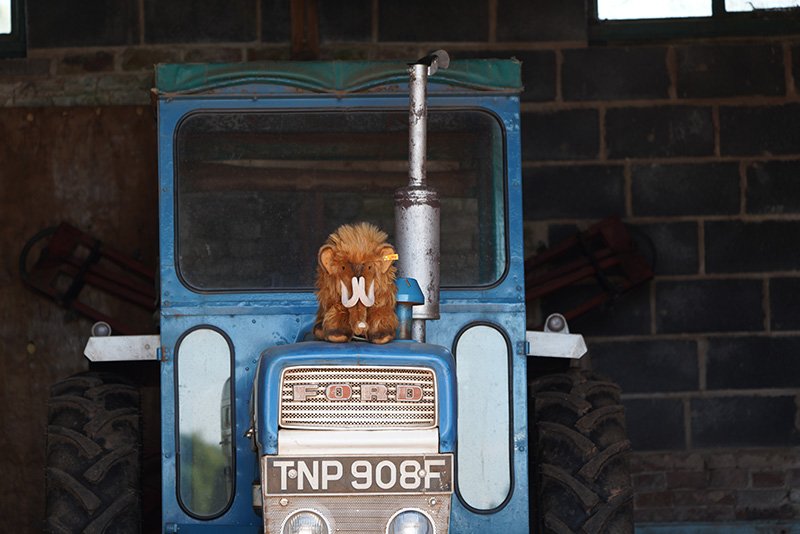
Sony a7R III + 100-400 @ 200mm | 1/50 | f/5.6 | ISO 100 | Full Resolution SOOC Download: JPEG | RAW **
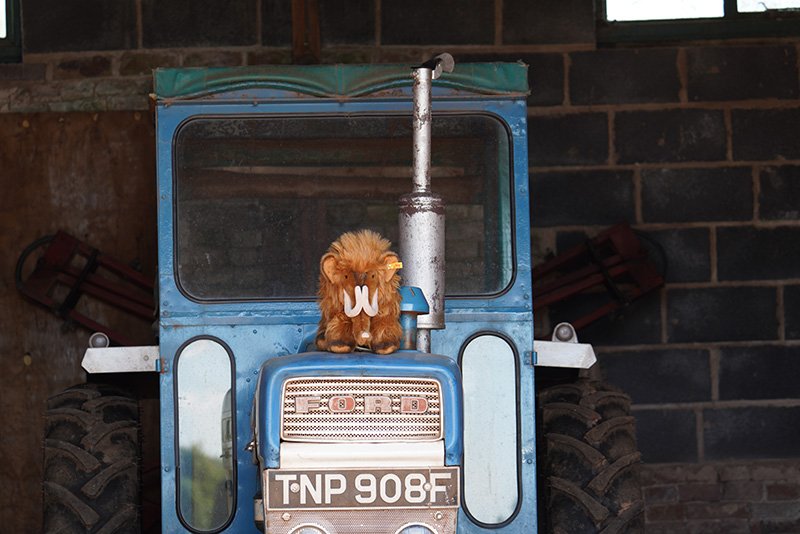
Sony a7R III + 200-600 @ 200mm | 1/40 | f/5.6 | ISO 100 | Full Resolution SOOC Download: JPEG | RAW **
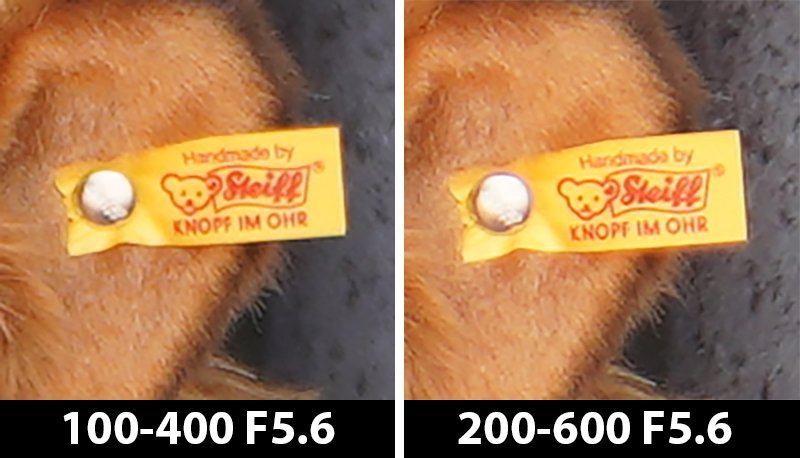
And here’s a 200% crop and side-by-side comparison:
To my eyes at least it’s very difficult to say that one image is clearly sharper than the other with this particular subject and at this shooting distance.
200mm Comparison 2
The next two images I shot from around 30m away and I focused on the first paragraph of text under “BBQ Book”. I shot wide open at f/5.6 on both lenses.
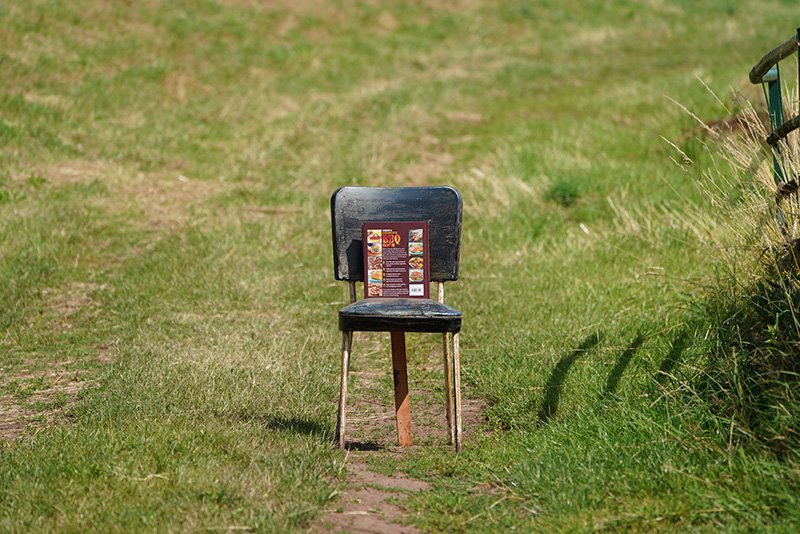
Sony a7R III + 100-400 @ 200mm | 1/500 | f/5.6 | ISO 100 | Full Resolution SOOC Download: JPEG | RAW **

Sony a7R III + 200-600 @ 200mm | 1/400 | f/5.6 | ISO 100 | Full Resolution SOOC Download: JPEG | RAW **

And here’s a 100% crop and side-by-side comparison:
Just like the previous two images, it’s difficult to say that one image is clearly sharper than the other with this subject and at this shooting distance. However, if I had to pick one I would say that the 100-400 is perhaps just the tiniest bit sharper in this example. Let me know if you agree in the comments below.
400mm Comparison 1
The following two images I shot again from around 15m away and I focused on Manny the Mammoth’s yellow label. I shot wide open on both lenses so that’s f/5.6 on the 100-400 and f/6.3 on the 200-600 at 400mm. Hit the links below each image to download the full sized images.
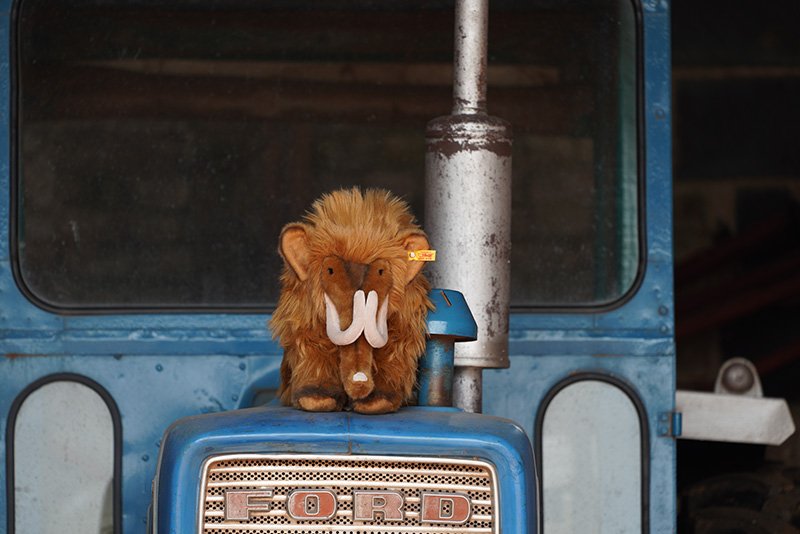
Sony a7R III + 100-400 @ 400mm | 1/100 | f/5.6 | ISO 100 | Full Resolution SOOC Download: JPEG | RAW **
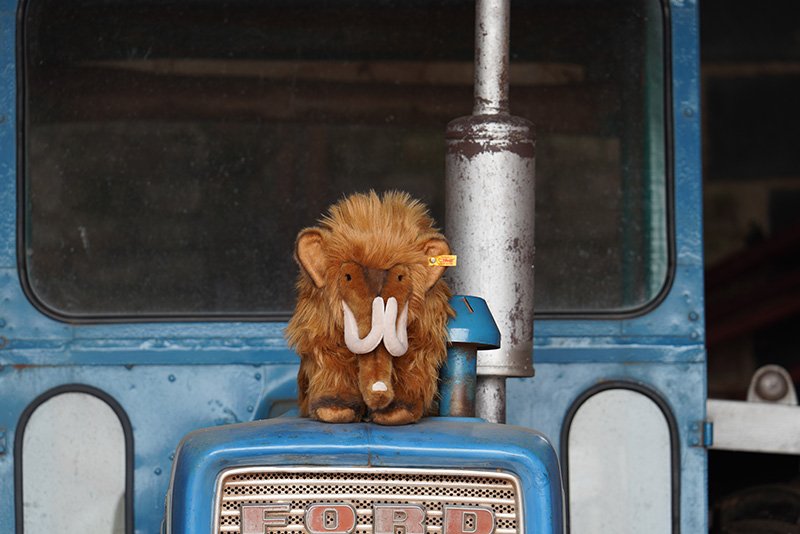
Sony a7R III + 200-600 @ 400mm | 1/60 | f/6.3 | ISO 100 | Full Resolution SOOC Download: JPEG | RAW **

And here’s a 100% crop and side-by-side comparison:
Although it’s very close, I think I’m going to have to give the 200-600 the win this time but only by a whisker.
400mm Comparison 2
The next two images I shot from around 30m away and I focused on the first paragraph of text under “BBQ Book”. I shot wide open at f/5.6 on the 100-400 and f/6.3 on the 200-600. I also stepped the 100-400 down to f/6.3 to do an equal aperture comparison.
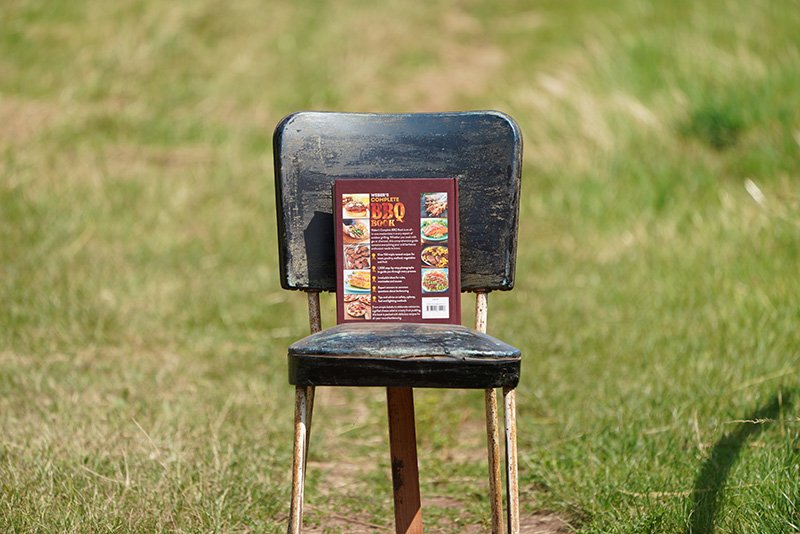
Sony a7R III + 100-400 @ 400mm | 1/400 | f/5.6 | ISO 100 | Full Resolution SOOC Download: JPEG | RAW **
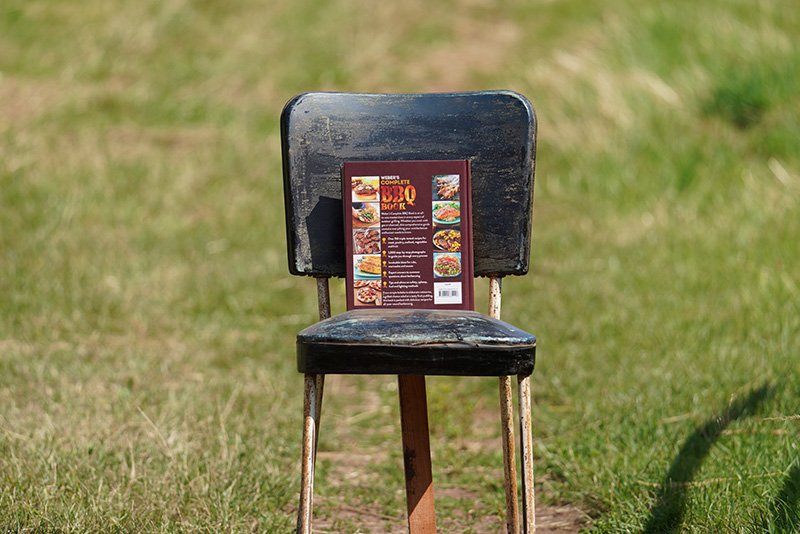
Sony a7R III + 200-600 @ 400mm | 1/400 | f/6.3 | ISO 100 | Full Resolution SOOC Download: JPEG | RAW **

And here’s a 100% crop and side-by-side comparison:
Although it’s very close again, the 200-600 is definitely a little bit sharper in this example. However, since I know that the 100-400 is a little sharper when you step down, here’s another 100% crop comparison but this time with the 100-400 at f/6.3 to match the aperture of the 200-600.

You can can clearly see that by stepping the 100-400 down to f/6.3 it now matches the sharpness of the 200-600 wide-open at f/6.3 but it doesn’t appear to improve upon it at least to my eyes. You can also download the full size f/6.3 shot in JPEG or RAW ** for your own viewing.
400mm Comparison 3
The next two images I shot from around 25m away and I focused on the “HPI Racing” text. I shot wide open at f/5.6 on the 100-400 and f/6.3 on the 200-600. I also again stepped the 100-400 down to f/6.3 to do an equal aperture comparison.

Sony a7R III + 100-400 @ 400mm | 1/800 | f/5.6 | ISO 100 | Full Resolution SOOC Download: JPEG | RAW **

Sony a7R III + 200-600 @ 400mm | 1/640 | f/6.3 | ISO 100 | Full Resolution SOOC Download: JPEG | RAW **
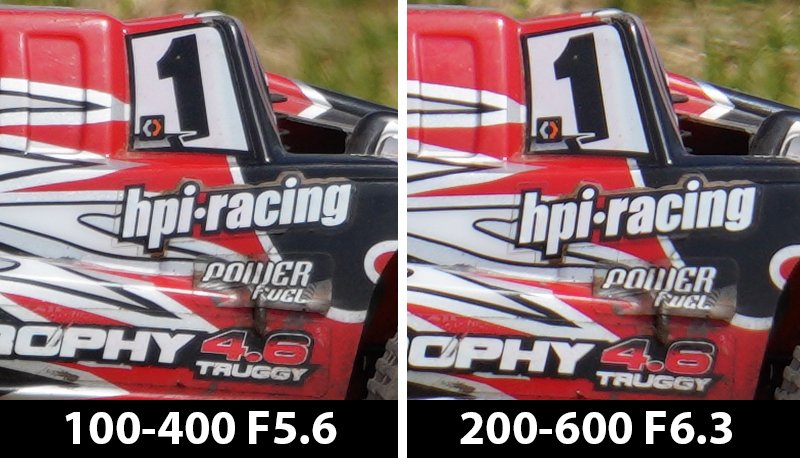
And here’s a 100% crop and side-by-side comparison:
It’s another very close fight, but if my eyes aren’t deceiving me then the 200-600 is again just that little bit sharper in this example, but certainly nothing to shout about.
Here’s another 100% crop comparison but this time with the 100-400 stepped down to f/6.3 again to match the aperture of the 200-600.
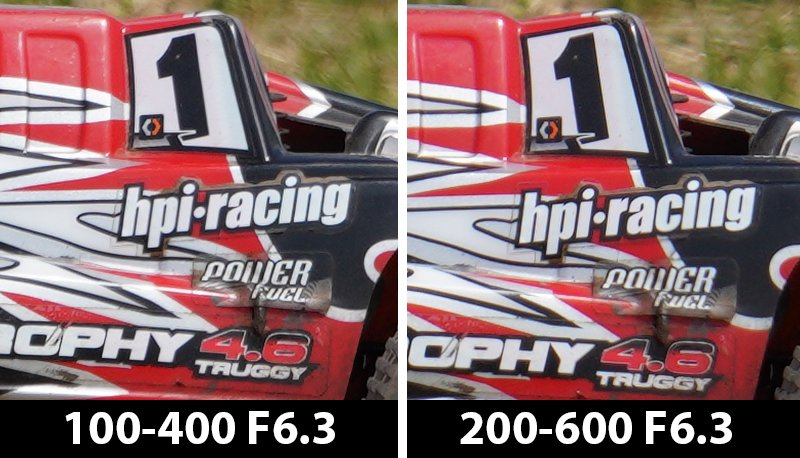
Just like the previous example when the 100-400 is stepped down to f/6.3 it now appears to match the sharpness of the 200-600 wide-open at f/6.3. You can also download the full size f/6.3 shot in JPEG or RAW ** for your own viewing.
At 560mm and 600mm Comparison 1
I’ve now added the Sony 1.4x teleconverter (SEL14TC) to the 100-400 to take the focal length to 560mm and the aperture down to f/8 wide-open (you lose one stop by adding the 1.4x).
I shot the 200-600 at 600mm and wide-open at f/6.3. The following two images I shot again from around 15m away and I focused on Manny the Mammoth’s yellow label.

Sony a7R III + 100-400 + 1.4x @ 560mm | 1/30 | f/8 | ISO 100 | Full Resolution SOOC Download: JPEG | RAW **
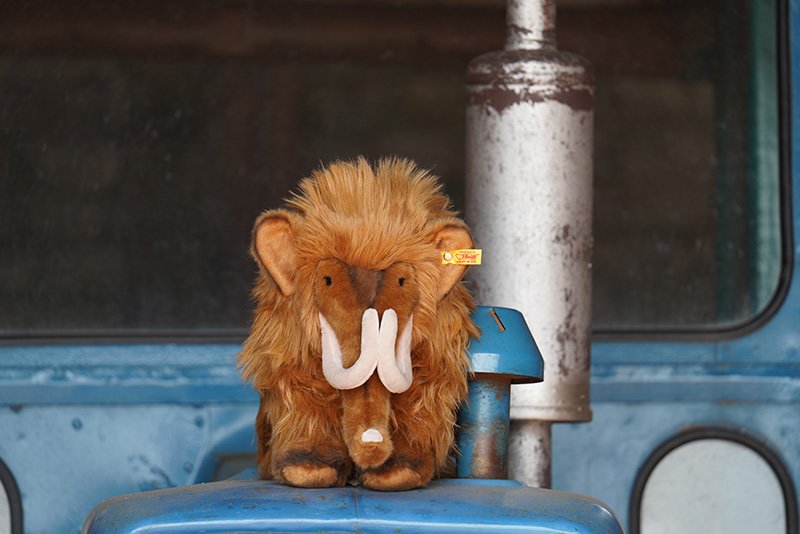
Sony a7R III + 200-600 @ 600mm | 1/60 | f/6.3 | ISO 100 | Full Resolution SOOC Download: JPEG | RAW **

And here’s a 100% crop and side-by-side comparison:
I think that it’s safe to say that the 200-600 at 600mm f/6.3 is sharper than the 100-400 + 1.4x at 560mm f/8, at least with this subject and shooting distance.
What if I now add the 1.4x to the 200-600mm to take it to 840mm and f/9? Here’s a 100% crop of the same image:

As you can see from this image, the 200-600 still retains excellent sharpness at 840mm f/9 when using the 1.4x teleconverter. You can also download the full size 840mm shot in JPEG or RAW ** for your own viewing.
At 560mm and 600mm Comparison 2
The next two images I shot from around 30m away and I focused on the first paragraph of text under “BBQ Book”. I shot wide open at f/8 on the 100-400 with the 1.4x at 560mm, and on the 200-600 at f/6.3and 600mm.
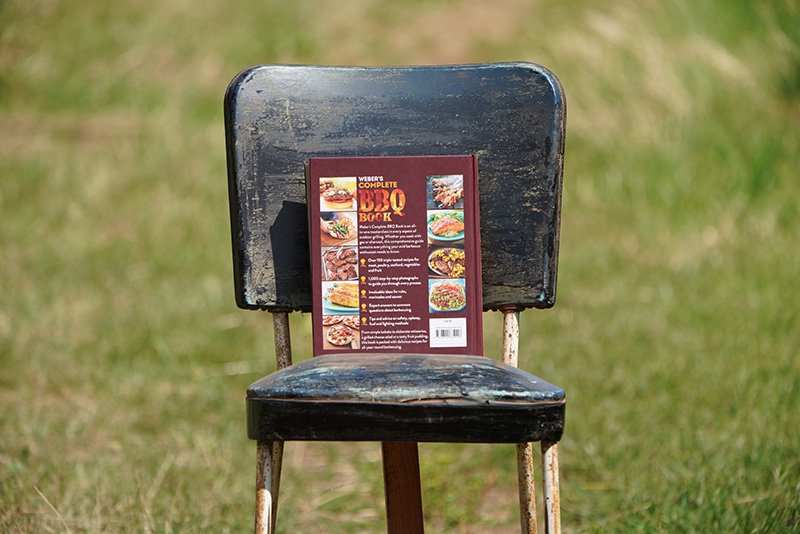
Sony a7R III + 100-400 + 1.4x @ 560mm | 1/30 | f/8 | ISO 100 | Full Resolution SOOC Download: JPEG | RAW **

Sony a7R III + 200-600 @ 600mm | 1/60 | f/6.3 | ISO 100 | Full Resolution SOOC Download: JPEG | RAW **

And here’s a 100% crop and side-by-side comparison:
Looking at these two images side-by-side it’s pretty clear to see that the 200-600 at 600mm f/6.3 is again sharper than the 100-400 + 1.4x at 560mm f/8, at least with this subject and shooting distance.
At 560mm and 600mm Comparison 3
The next two images I shot from around 100m away and I focused on the window. I shot wide open at f/8 on the 100-400 + 1.4x at 560mm, and on the 200-600 at f/6.3 and 600mm. I used my a9 for these shots.
Unfortunately the weather wasn’t playing nice and the light was changing pretty fast which made it harder to balance the exposure between shots. There was also a good breeze so I shot at 1/1000 to eliminate any movement but this pushed up the ISO. Full size SOOC JPEG’s are available to download but I forgot I was shooting my a9 in JPEG only so no RAW files this time I’m afraid.
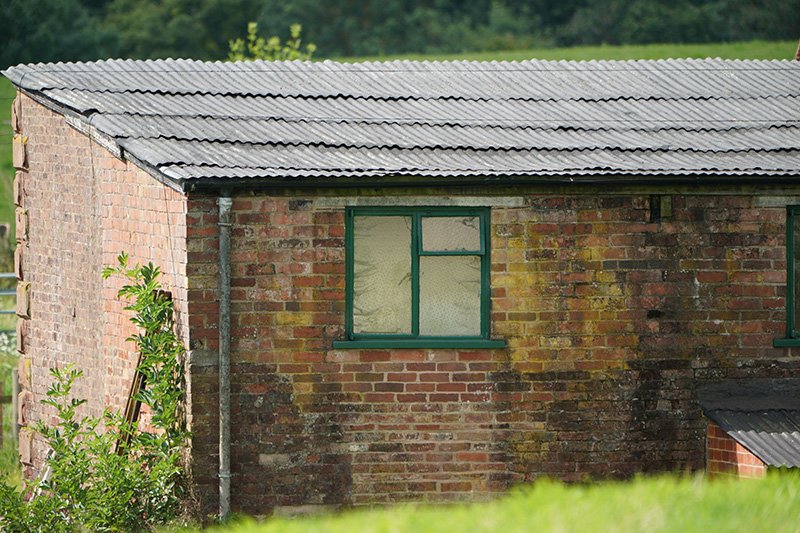
Sony a9 + 100-400 + 1.4x @ 560mm | 1/1000 | f/8 | ISO 1000 | Full Resolution SOOC Download: JPEG

Sony a9 + 200-600 @ 600mm | 1/1000 | f/6.3 | ISO 1250 | Full Resolution SOOC Download: JPEG

And here’s a 100% crop and side-by-side comparison:
It’s clear again that the 200-600 at 600mm is sharper than the 100-400 + 1.4x teleconverter at 560mm.
Now again adding the 1.4x to the 200-600mm to take it to 840mm and f/9. Here’s a 100% crop of the same image:

Again the 200-600 still retains very good sharpness at 840mm f/9 when using the 1.4x teleconverter. You can also download the full size 840mm shot in JPEG for your own viewing.
Sharpness Summary
Shooting wide-open at 200mm I’m really not seeing any big differences in sharpness between the lenses.
At 400mm it appears that the 200-600 could possibly have a very small sharpness advantage over the 100-400 at f/5.6. But when you step the 100-400 down to f/6.3 both lenses appear to be equally sharp.
I was actually expecting the 100-400mm to be sharper than the 200-600 at 400mm when shooting wide-open, so I’m rather surprised to see these results. I even thought that perhaps my 100-400 GM has quality issues and could possibly be decentered, but I checked and it isn’t. Still, I wanted to be certain of these results so I hired another 100-400 GM for a couple of days but the results were the same.
Adding the teleconverter to the 100-400 to take it to 560mm and f/8 definitely impacts the image quality, and it’s fairly clear from the images I’ve shot so far that the 200-600 at 600mm f/6.3 is the sharper lens by a good margin when you start to pixel peep.
Adding the 1.4x teleconverter to the 200-600 to take it to 840mm and f/9 does not appear to impact the image quality as much as it does on the 100-400. Still, I’d like to do further comparisons to confirm this, along with some comparisons with the 2x teleconverter.
Vignetting Comparison
Vignetting, also known as “light fall-off” is simply the darkening of image corners when compared to the center. If you are shooting JPEG’s then vignetting can be controlled using in-camera lens corrections and if you are shooting raw then you can apply lens corrections in post.
The following exciting sky shots have been taken with in-camera lens corrections turned both on and off, when turned off they also match what is seen in the raw files.
Vignetting at 200mm
At 200mm and shooting wide-open both lenses show no signs of vignetting with lens corrections turned on. Turn off the corrections and the 200-600 clearly shows that the lens corrections are working harder at 200mm than the 100-400.
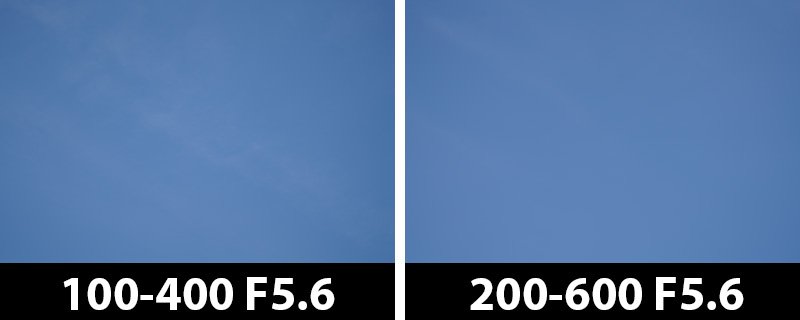
With Lens Corrections Turned On

With Lens Corrections Turned Off
Vignetting at 400mm
At 400mm and shooting wide-open both lenses show no signs of vignetting with lens corrections turned on. Turn off the corrections and the 100-400 displays heavier vignetting than the 200-600.
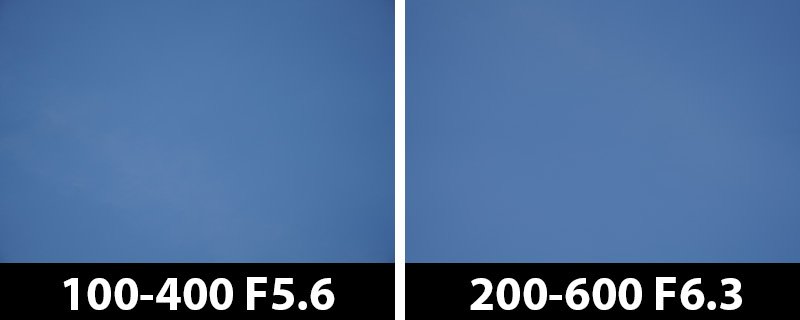
With Lens Corrections Turned On
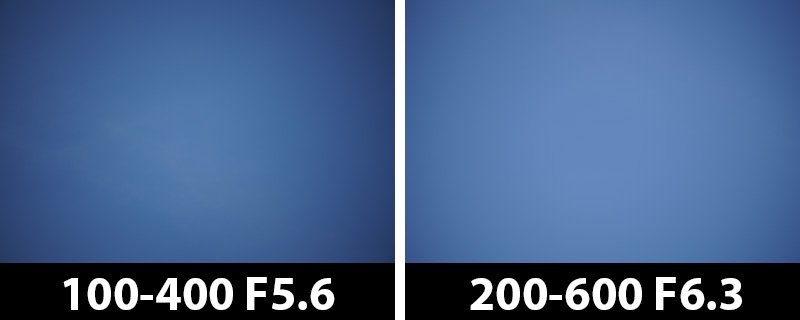
With Lens Corrections Turned Off
Vignetting at 560mm / 600mm
Adding the 1.4x teleconverter (SEL14TC) to take the 100-400 to 560mm / f8 and you’ll see signs of vignetting even when lens corrections are turned on, whereas the 200-600mm displays no signs of vignetting. Turning off lens corrections and both lenses now show signs of mild vignetting, although the corners are much darker with the 100-400.

With Lens Corrections Turned On
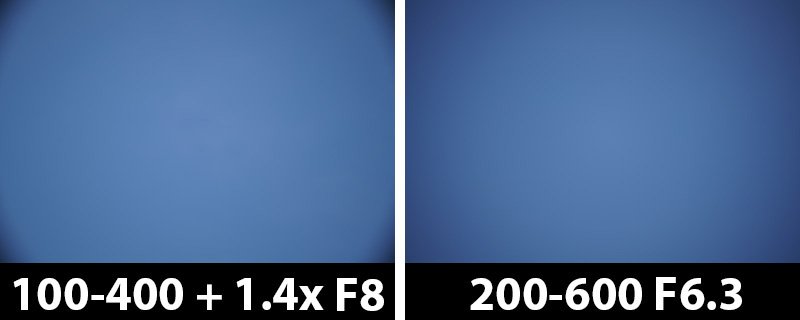
With Lens Corrections Turned Off
Vignetting with 1.4x Teleconverter at 560mm / 840mm
Now comparing both lenses with the 1.4x (SEL14TC) attached and shooting wide-open you’ll see that with lens corrections turned on the 200-600 displays only a hint of vignetting. Turning off lens corrections and again both lenses now show signs of mild vignetting, although the corners are still much darker with the 100-400.
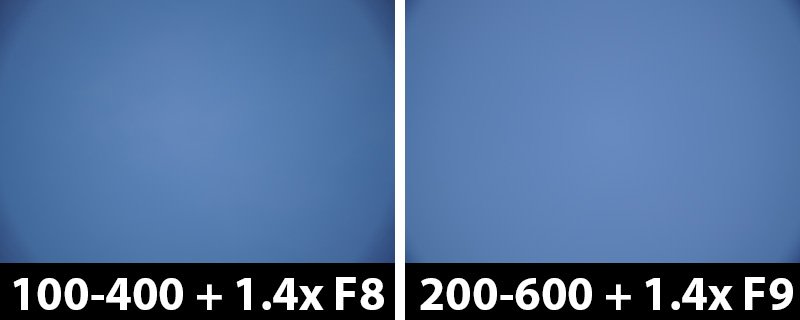
With Lens Corrections Turned On

With Lens Corrections Turned Off
Vignetting with 2x Teleconverter at 800mm / 1200mm
Now comparing both lenses with the 2x (SEL20TC) attached and shooting wide-open, you’ll see that with lens corrections turned on both lenses are well corrected in-camera. Turning off lens corrections and the 100-400 shows a small amount of light fall-off in the corners whereas the 200-600 is pretty much vignetting free.

With Lens Corrections Turned On

With Lens Corrections Turned Off
Vignetting Summary
With in-camera lens corrections turned on you’ll struggle to spot any signs of vignetting at 200mm and 400mm with both lenses, turn off the corrections and the 100-400 displays heavier vignetting than the 200-600 at 400mm.
Taking the 100-400 to 560mm with the 1.4x teleconverter and you’ll now see signs of vignetting even with corrections turned on, whereas the 200-600 shows no signs of vignetting at 600mm with corrections turned on. Turning off lens corrections and both lenses now show signs of mild vignetting, although the corners are much darker with the 100-400.
Add the 1.4x (SEL14TC) teleconverter to the 200-600 to take it to 840mm / f/9 and you’ll see a very small amount of vignetting with corrections turned on, but it’s an improvement over the 100-400 + 1.4x. Turn off lens corrections and the 200-600 now shows signs of mild vignetting.
Finally adding the 2x (SEL20TC) teleconverter and shooting at the maximum focal length and aperture you’ll see that both lenses show no signs of vignetting with corrections turned on. Turning off lens corrections and the 100-400 shows a small amount of light fall-off in the corners whereas the 200-600 is pretty much vignetting free.
So basically other than at 200mm where the 100-400 takes the win, the 200-600 is much better controlled for vignetting at 400mm, 600mm and when both the 1.4x and 2x teleconverters are added.
Chromatic Aberration
Let’s see how well both the 100-400 GM and the 200-600 G compare when it comes to their handling of Chromatic Aberration (CA), also known as “color fringing” or “purple fringing”.
Longitudinal Chromatic Aberration
Longitudinal Chromatic Aberration, also known as “LoCA”.
400mm vs 600mm
The following shots were taken with both lenses at their maximum focal lengths and apertures. So the 100-400 was at 400mm f/5.6 and the 200-600 at 600mm f/6.3.
With Lens Corrections Turned Off
The following image comparison is a 100% crop from the center of the frame with lens corrections turned off.

The following image comparison is a 100% crop from the edge of the frame with lens corrections turned off.
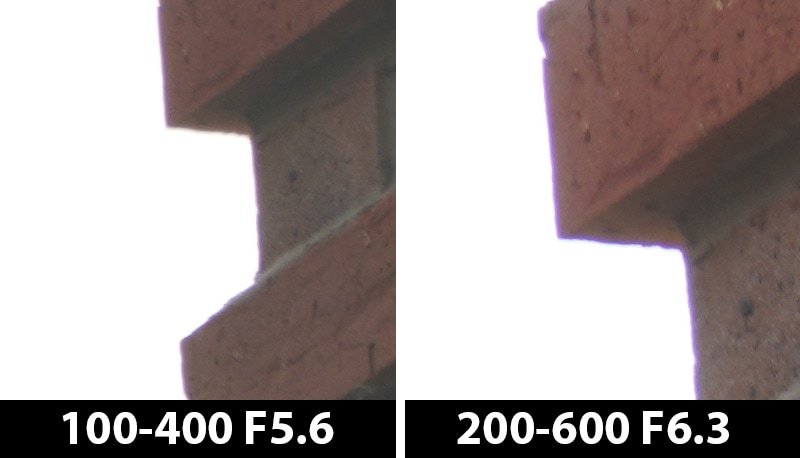
As you can hopefully see the 100-400 shows no signs of CA either in the center of the frame and only the smallest amount towards the edge of the frame with lens corrections turned off. The 200-600 however shows clear signs of CA in the center of the frame and at the edges, with the edge CA being more pronounced than the center.
With Lens Corrections Turned On
The following image comparison is a 100% crop from the center of the frame with lens corrections turned on.
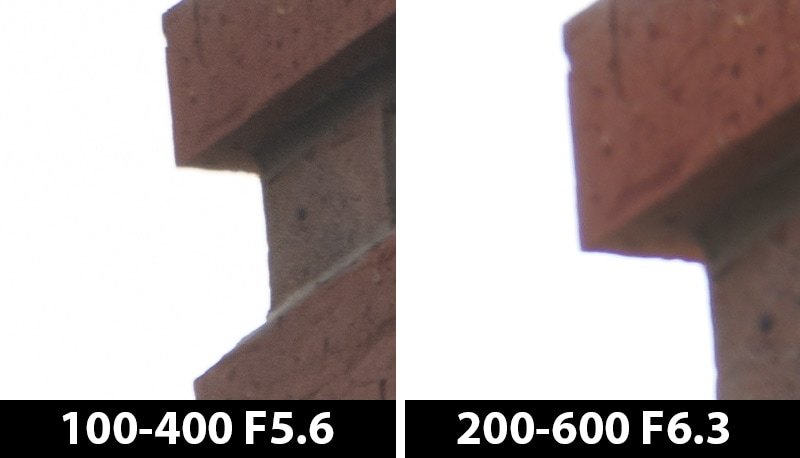
The following image comparison is a 100% crop from the edge of the frame with lens corrections turned on.

The 100-400 shows no signs of CA either in either the center or towards the edge of the frame when lens corrections are turned on. The 200-600 still shows clear signs of CA in the center of the frame and at the edges, with the edge CA being more pronounced than the center even with lens corrections turned on.
Chromatic Aberration Summary
At least when shooting at their respective maximum focal lengths and apertures the 100-400 appears to handle CA a lot better than the 200-600. It shows no signs of CA in the center of the frame with corrections turned on and only the smallest amount of CA towards the edges. Turn on lens corrections as there is no VA visible anywhere in the frame.
The 200-600 is showing signs of CA both in the center of the frame and towards the edges where it becomes more pronounced. Turning on lens corrections helps to reduce the CA but it’s not removed completely and you may need to apply further CA removal in post if shooting subjects with high contrast. If you step the lens down to f/11 then CA is no longer visible but I doubt many of us will be shooting at f/11.
This is a pretty extreme test and thankfully I’ve not spotted any CA in the real world images that I’ve shot with the 200-600 so far, but I will certainly be keeping an eye out for this.
Color Rendition
I shot the following color chart on my Sony a7III to see how each lens renders color, both images are unprocessed raw files.
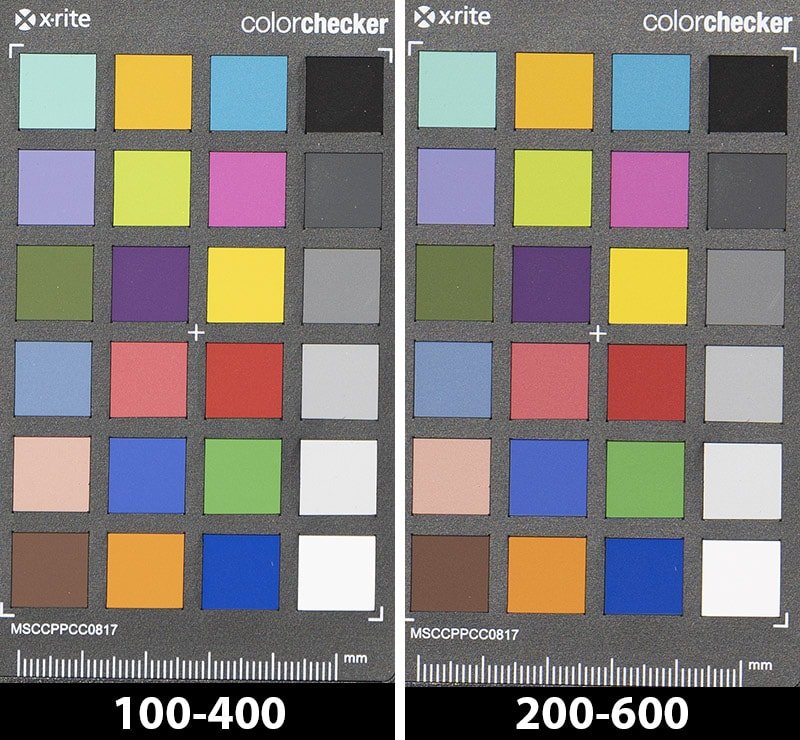
We all perceive color differently so this test will be somewhat subjective. To my eyes it looks like the 200-600 has a little more contrast but there’s really very little in it and if you process your images anyway this is really a moot point.
Autofocus Test with Frank
In the following video featuring my dog Frank I tested both lenses at 400mm, then added the 1.4x to the 100-400 and tested it at 560mm vs the 200-600 at 600mm. Both lenses were shot wide-open and I used 4 different cameras: the a6400, a7III, a7R III and a9 to give you an idea of how it performs on each camera, since the camera used will always impact the AF performance of the lens.
Overall the 100-400 at 400mm had a keeper rate of 96% compared to 93% of the 200-600 at 400mm. However, the tables were turned when I added the 1.4x to the 100-400 which reduced the keeper rate to 92% at 560mm, this compared to 95% with the 200-600 at 600mm.
The a7R III had an overall keeper rate of 85% compared to 87% for both the a6400 and a7III. The a9 didn’t miss a shot with a keeper rate of 100%. Of course Frank is not the most challenging of subjects but he was the most convenient for testing so many cameras and focal lengths.
Here are some of the images from the test shoot. The light was changeable so it was impossible to balance the exposures perfectly between shots. I was also shooting in JPEG only so no RAW files I’m afraid.
Sony a6400 Autofocus Test at 400mm
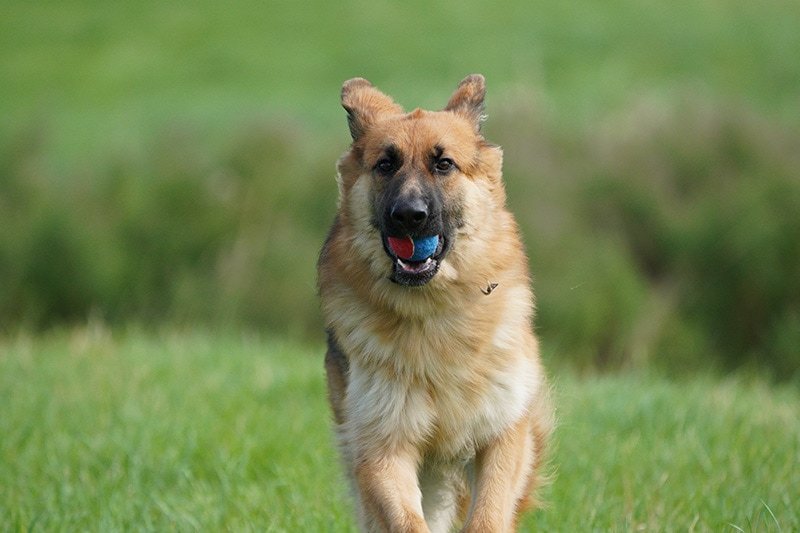
Sony a6400 + 100-400 @ 400mm | 1/2000 | f/5.6 | ISO 800 | Full Resolution SOOC Download: JPEG
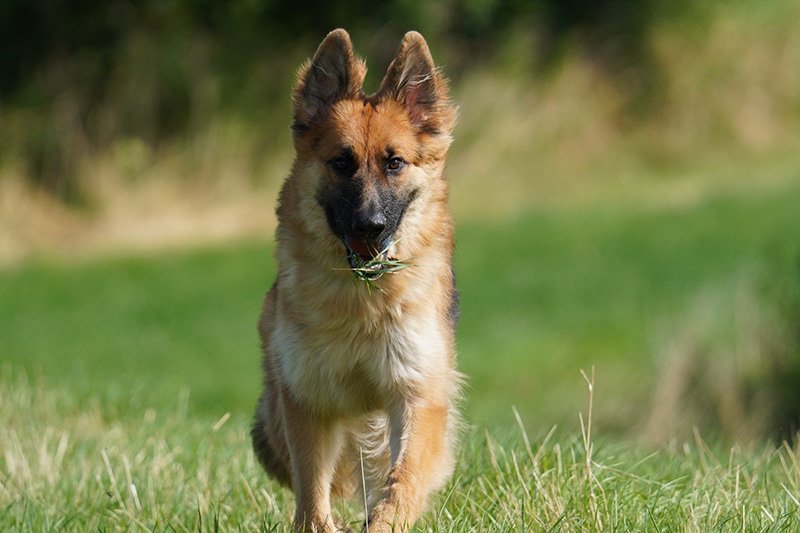
Sony a6400 + 200-600 @ 400mm | 1/2000 | f/6.3 | ISO 500 | Full Resolution SOOC Download: JPEG
Sony a6400 Autofocus Test at 560mm / 600mm
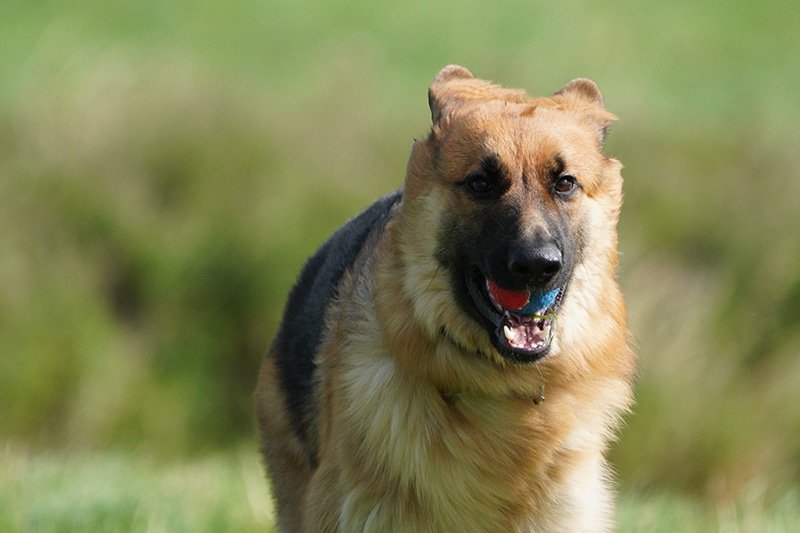
Sony a6400 + 100-400 + 1.4x @ 560mm | 1/2000 | f/8 | ISO 1000 | Full Resolution SOOC Download: JPEG

Sony a6400 + 200-600 @ 600mm | 1/2000 | f/6.3 | ISO 640 | Full Resolution SOOC Download: JPEG
If you download and take a closer look at the images you’ll struggle to spot much difference at 400mm between the lenses, but the 200-600 wins again at 600mm when compared with the 100-400 + 1.4x at 560mm.
Sony a7III Autofocus Test at 400mm

Sony a7III + 100-400 @ 400mm | 1/2000 | f/5.6 | ISO 640 | Full Resolution SOOC Download: JPEG

Sony a7III + 200-600 @ 400mm | 1/2000 | f/6.3 | ISO 800 | Full Resolution SOOC Download: JPEG
Sony a7III Autofocus Test at 560mm / 600mm
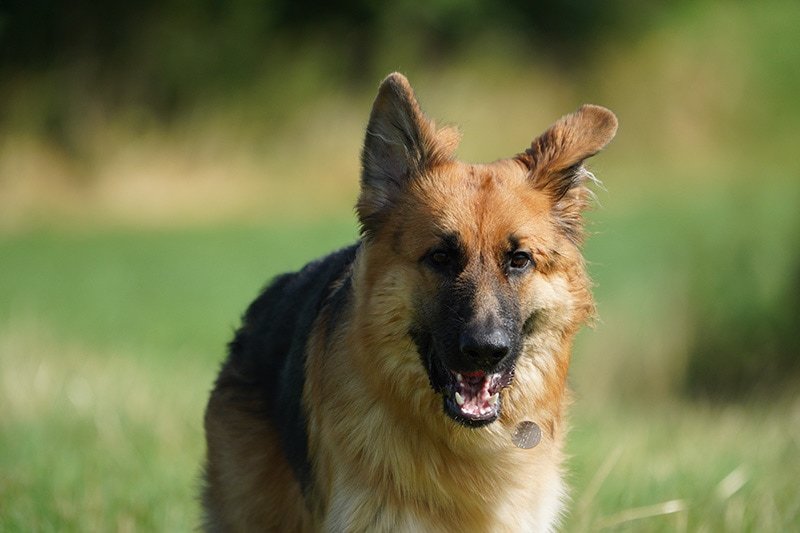
Sony a7III + 100-400 + 1.4x @ 560mm | 1/2000 | f/8 | ISO 1250 | Full Resolution SOOC Download: JPEG

Sony a7III + 200-600 @ 600mm | 1/2000 | f/6.3 | ISO 640 | Full Resolution SOOC Download: JPEG
Sony a7R III Autofocus Test at 400mm
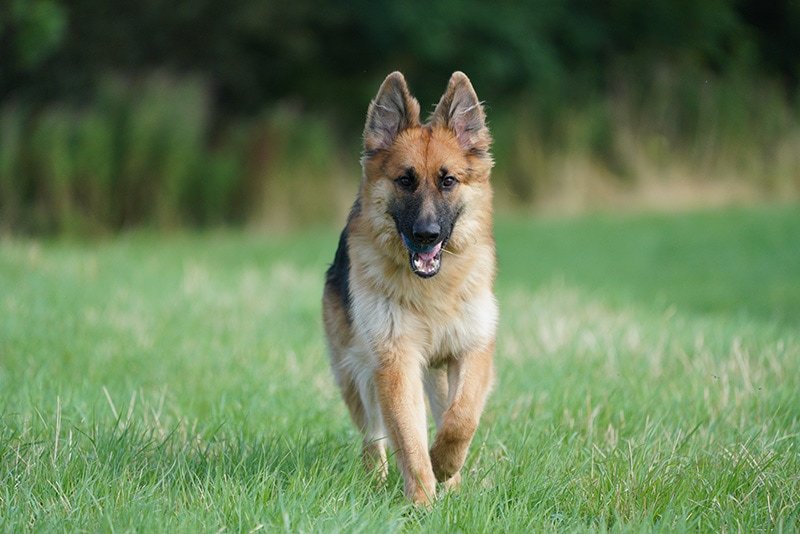
Sony a7R III + 100-400 @ 400mm | 1/2000 | f/5.6 | ISO 1600 | Full Resolution SOOC Download: JPEG

Sony a7R III + 200-600 @ 400mm | 1/2000 | f/6.3 | ISO 1250 | Full Resolution SOOC Download: JPEG
Sony a7R III Autofocus Test at 560mm / 600mm

Sony a7R III + 100-400 + 1.4x @ 560mm | 1/2000 | f/8 | ISO 2000 | Full Resolution SOOC Download: JPEG

Sony a7R III + 200-600 @ 600mm | 1/2000 | f/6.3 | ISO 2000 | Full Resolution SOOC Download: JPEG
Sony a9 Autofocus Test at 400mm
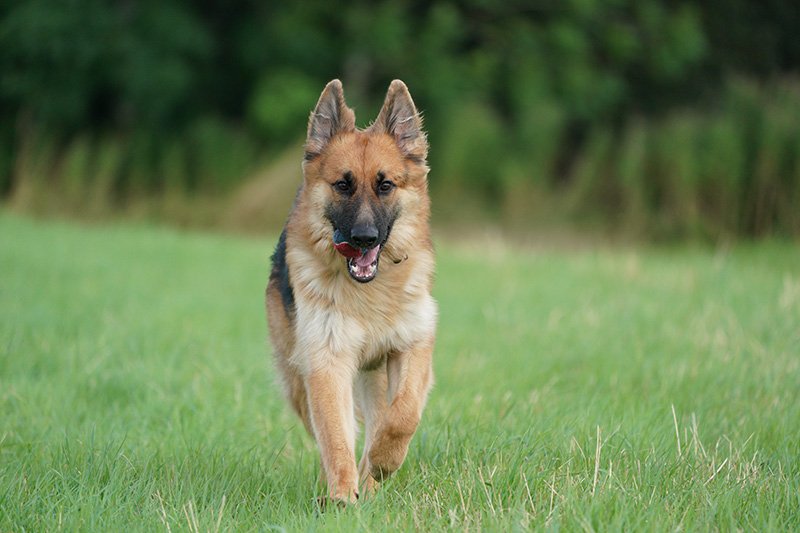
Sony a9 + 100-400 @ 400mm | 1/2000 | f/5.6 | ISO 1250 | Full Resolution SOOC Download: JPEG
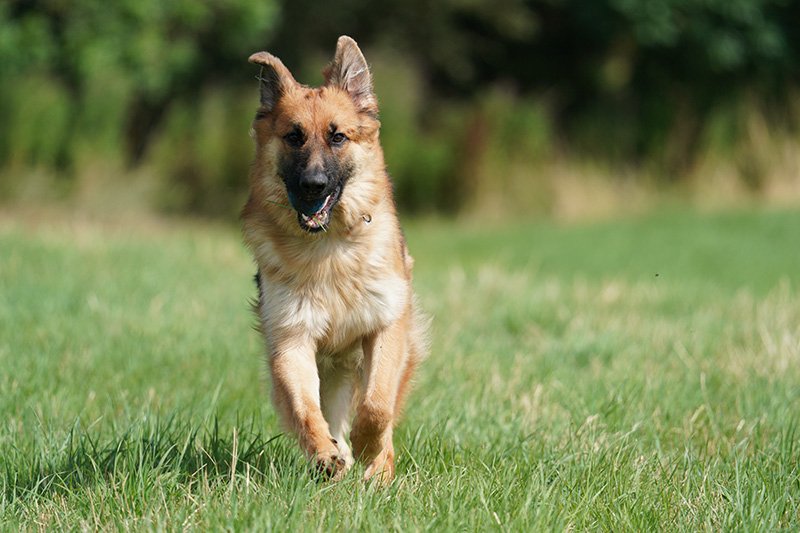
Sony a9 + 200-600 @ 400mm | 1/2000 | f/6.3 | ISO 500 | Full Resolution SOOC Download: JPEG
Sony a9 Autofocus Test at 560mm / 600mm
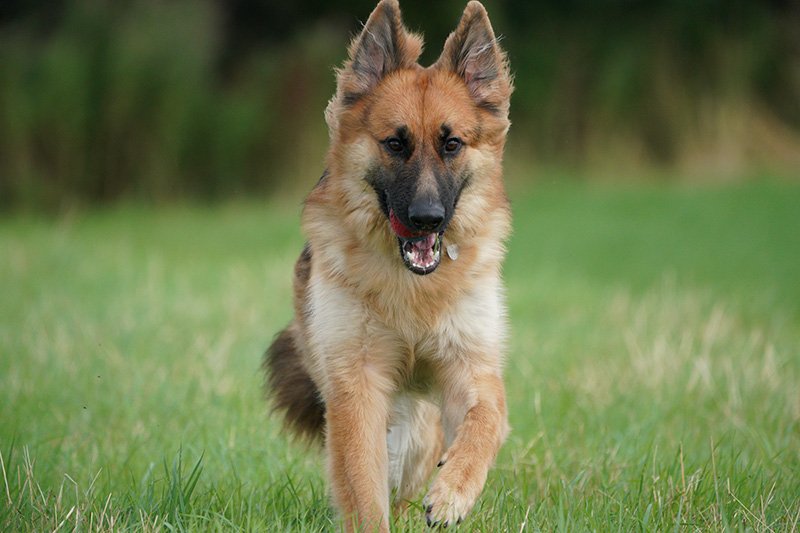
Sony a9 + 100-400 + 1.4x @ 560mm | 1/2000 | f/8 | ISO 2000 | Full Resolution SOOC Download: JPEG

Sony a9 + 200-600 @ 600mm | 1/2000 | f/6.3 | ISO 1600 | Full Resolution SOOC Download: JPEG
Autofocus Test with Birds in Flight
In the following video I show a comparison of using the 200-600 vs 100-400 + 1.4x for shooing birds in flight. The bird in this case is the red kite and since my time at this location was limited I was only able to use the Sony a7III to make sure that I got the video and shots needed.
Both lenses were shot at their maximum focal lengths and apertures, so the 200-600 was at 600mm f/6.3 and the 100-400 + 1.4x was at 560mm f/8.
I was using AF-C mode together with a wide focus area, tracking sensitivity was set to 5 although it should have been set to 1 (locked-on), unfortunately I mixed them up on the day! But even with sensitivity 5 both lenses locked on and tracked very well and there were probably only a couple of instances where 1 would have helped. Shutter speed was 1/2000 and ISO was set to Auto. Everything was shot handheld and I used panning mode 2 on both lenses.
I also used the Olympus EE-1 Dot Sight (B&H Photo / Amazon) to help make locating and tracking the kites in the sky far easier than using the EVF or LCD.
Both lenses performed equally as well when it came to locking on and tracking the red kites. However, the 200-600 gave me around 10% more keepers than the 100-400 + 1.4x and also all of the keepers shot with the 200-600 were sharper.
You can find the sample photos from this video in the sample gallery towards the end of this article.
Minimum Focus Distance
If you enjoy shooting bugs then the 100-400 offers the shortest minimum focusing distance of just 0.98m (3.22 ft). Whereas the 200-600 requires 2.4m (7.88 ft) to focus correctly.
Here are a couple of comparison images to give you an idea as to how close to your subject each lens will bring you at their respective minimum focus distances, the images have not been cropped.

Sony 100-400mm at 400mm

Sony 200-600mm at 600mm
I think the images speak for themselves here. The 100-400 most definitely comes out on top for close-up shots!
Specifications Comparison
| Lens Specifications | Sony FE 200-600 F5.6-6.3 G | Sony FE 100-400 F4.5-5.6 GM |
|---|---|---|
| Lens Mount: | Sony E-Mount | Sony E-Mount |
| Format: | 35mm full frame | 35mm full frame |
| Focal Length (mm): | 200-600 | 100-400 |
| 35mm Equivalent Focal Length (APS-C): | 300-900 | 150-600 |
| Focus Motors: | DDSSM | Double Linear Motor + DDSSM |
| Lens Groups / Elements: | 17-24 | 16-22 |
| Angle of View (35mm): | 12°30′-4°10′ | 24゚-6゚10′ |
| Angle of View (APS-C): | 8°-2°40′ | 16°-4°10′ |
| Maximum Aperture: | 5.6-6.3 | 4.5-5.6 |
| Minimum Aperture: | 32-36 | 32-40 |
| Aperture Blades: | 11 | 9 |
| Circular Aperture: | Yes | Yes |
| Minimum Focus Distance: | 2.4m (7.88 ft) | 0.98m (3.22 ft) |
| Maximum Magnification Ratio (x): | 0.2 | 0.35 |
| Filter Diameter (mm): | 95 | 77 |
| Image Stabilization (OSS): | Yes (3 modes) | Yes (2 modes) |
| Zoom System: | Manual Internal | Manual External |
| Teleconverter Compatibility x1.4: | SEL14TC | SEL14TC |
| Teleconverter Compatibility x2.0: | SEL20TC | SEL20TC |
| Diameter (mm): | 111.5 mm (4 1/2 in.) | 93.9 mm (3-3/4 in.) |
| Length (mm): | 318 mm (12 5/8 in.) | 205 mm – 280 mm (8-1/8 – 11 in.) |
| Weight: | 2115g without tripod mount | 1395g without tripod mount |
| Press Release Date: | June 11, 2019 | April 19, 2017 |
| Price (MRRP): | $1,998.00 / £1,799.00 | $2,498.00 / £2,449.00 |
| Reviews: | My Review |
Now let’s take a closer look at some of the more interesting specs here.
Focal Length and Aperture
The Sony FE 100-400 GM has a variable aperture of f/4.5 – 5.6 and it jumps to f/5.6 at 164mm, the maximum focal length is 400mm. The Sony FE 200-600mm G also has a variable aperture but this time it’s from f/5.6 – 6.3 and it jumps to f/6.3 at 300mm, the maximum focal length is 600mm.
Focus Motors
The Sony 100-400mm GM uses a combination of double linear motor and DDSSM (Direct Drive SSM). Whereas the 200-600mm only uses the Direct Drive SSM motors, this may give the 100-400mm an advantage when it comes to focusing speed.
Zoom System
The barrel of the 100-400mm extends when you zoom by around 80mm. The 200-600mm on the other hand features an internal zoom mechanism that does not extend, therefore you don’t need to worry about zoom creep and there are no balance issues as you zoom in and out.
Size and Weight
The 100-400mm measures 205mm in length at 100mm which extends to 280mm at 400mm; the diameter is 94mm and it weights 1395g without the tripod mount attached. The 200-600mm is 318mm in length, has a diameter of 111.5mm, and weighs 2115g without the tripod mount, making the 200-600 around 720g heavier.
Aperture Blades
The 100-400mm features 9 circular aperture blades, whereas the 200-600mm has 11 circular aperture blades. This should mean that the 200-600mm is capable of producing slightly smoother bokeh balls.
Teleconverter Support
Both lenses support Sony’s 1.4x (SEL14TC) and 2.0x (SEL20TC) teleconverters. The 1.4x will extend the reach of the 100-400mm to a maximum of 560mm at f/8, and the 200-600mm to a maximum reach of 840mm at f/9.
The 2.0x extends the 100-400mm to a maximum of 800mm at f/11 and the 200-600mm to a maximum of 1200mm at f/13.
It’s important to note that focal plane phase detection AF cannot be used with apertures of f/9 or above on many e-mount cameras, currently only the Sony a7III, a6500, a6400 and a6300 support focal plane phase detection AF higher than f/9 but also to a maximum aperture of f/11, and the Sony a9 supports phase detection up to f/16. If phase detection cannot be used then the camera will still use contrast detection.
Minimum Focus Distance
The minimum focus distance of the 100-400mm is 0.98m (3.22 ft) which also makes this lens ideal for macro photography. The 200-600mm has a much greater minimum focus distance of 2.4m (7.88 ft).
Image Stabilization (OSS)
Both lenses feature Optical Image Stabilization (OSS) with mode 1 stabilizing on both horizontal and vertical axis, and mode 2 stabilizing on only the vertical axis for panned shots. The 200-600mm lens also has an additional mode 3 setting that provides stabilization for tracking and shooting dynamic, unpredictable sports action.
Range Focus Limiter
The 100-400mm has only two options for limiting the auto focus distance, these are from 3 meters to infinity and full-range. The 200-600mm has three options for limiting the focus distance, you can choose between 2.4 – 10 meters, 10 meters to infinity, or full-range. This can help speed up autofocus in some situations by preventing the lens from focusing on subjects outside the target range.
Price
The Sony FE 100-400mm GM has a RRP of $2,498.00 / £2,449.00 and the Sony FE 200-600mm G has a RRP of $1,998.00 / £1,799.00, making the 200-600mm the more affordable lens.
Sample Image Gallery
You probably won’t be shooting any of the subjects that I’ve used for comparison images throughout this article, so here’s a handful of sample images from subjects that you are more likely to shoot. Some images are cropped to my liking but no other post processing has been done.
Sony FE 200-600 Sample Photos
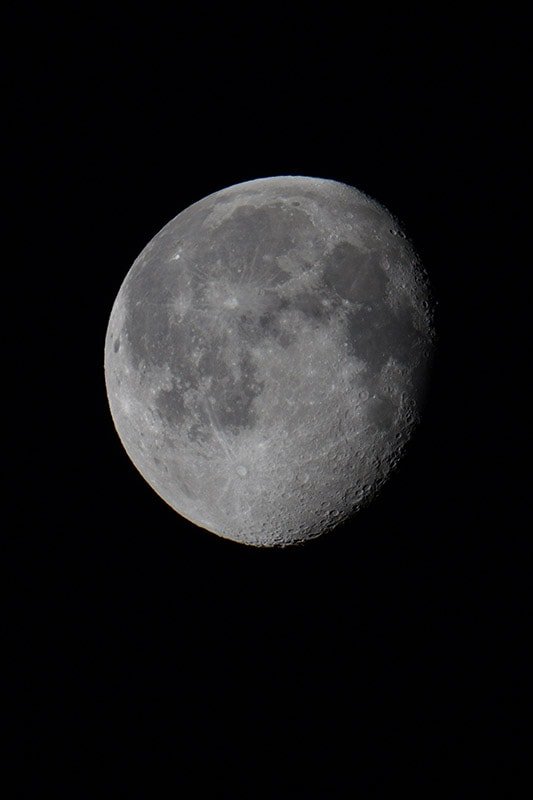
Sony a7R IV + 200-600 + 1.4x @ 840mm | 1/500 | f/9 | ISO 400 | Crop | Full Resolution SOOC Download: JPEG | RAW **
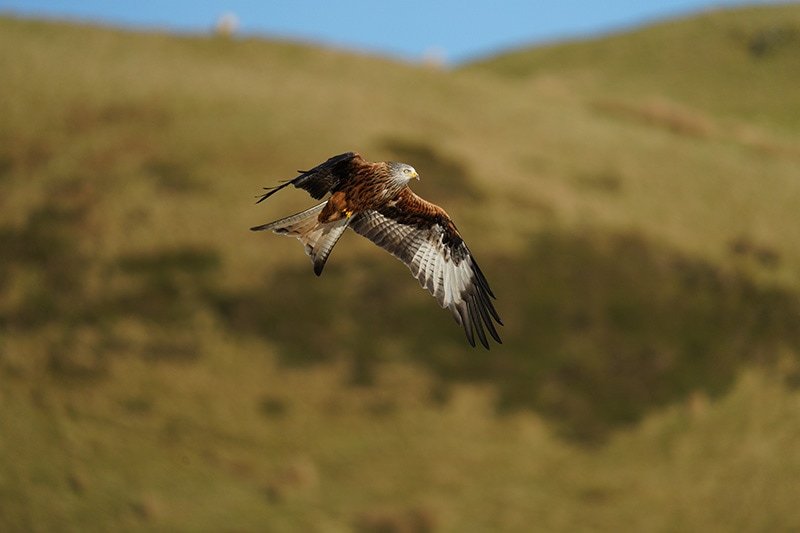
Sony a7R IV + 200-600 @ 600mm | 1/2500 | f/6.3 | ISO 640 | Full Resolution SOOC Download: JPEG | RAW **

Sony a7R IV + 200-600 @ 600mm | 1/2000 | f/6.3 | ISO 400 | Full Resolution SOOC Download: JPEG
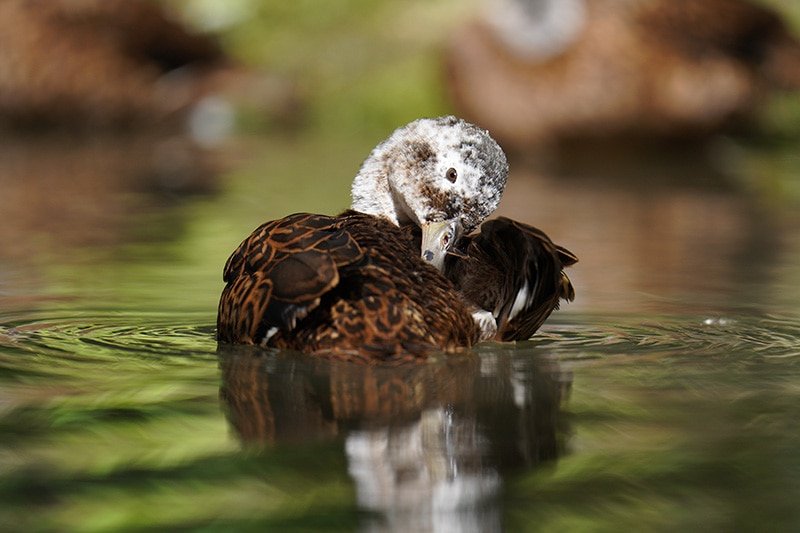
Sony a7 III + 200-600 @ 600mm | 1/1000 | f/6.3 | ISO 640 | Full Resolution SOOC Download: JPEG | RAW **
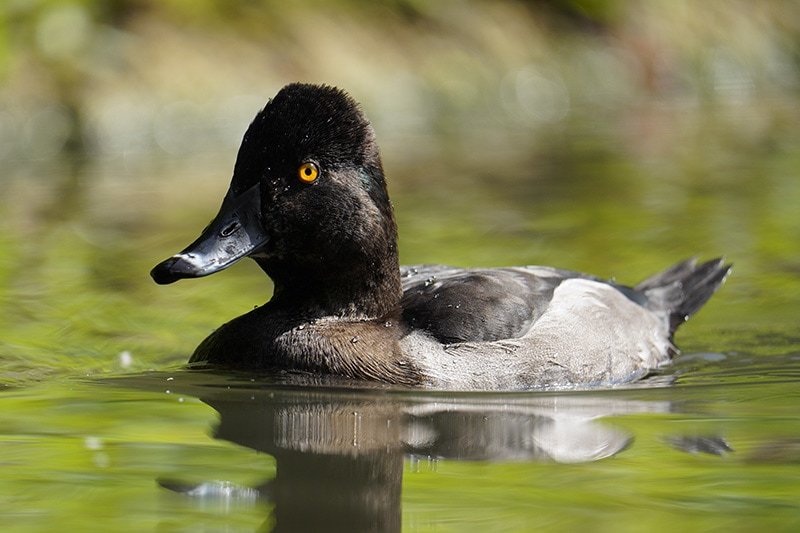
Sony a7 III + 200-600 @ 600mm | 1/1000 | f/6.3 | ISO 400 | Full Resolution SOOC Download: JPEG | RAW **

Sony a7 III + 200-600 @ 600mm | 1/1000 | f/6.3 | ISO 400 | Full Resolution SOOC Download: JPEG | RAW **
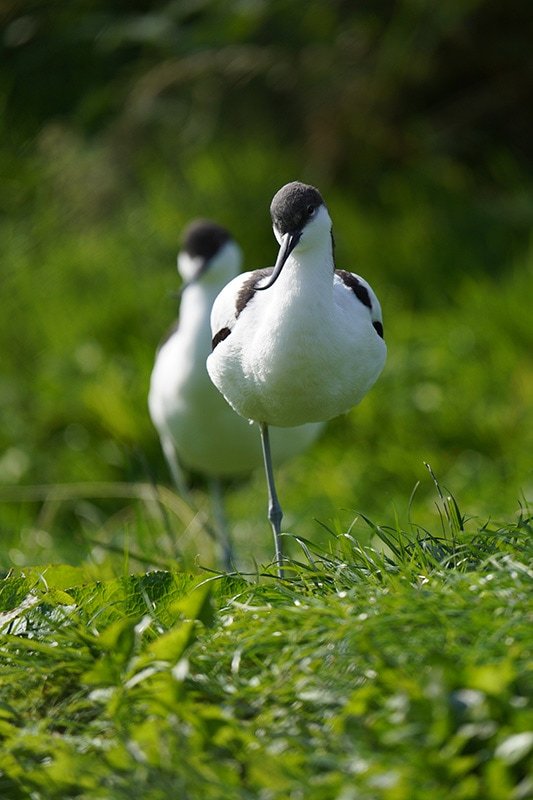
Sony a7 III + 200-600 @ 600mm | 1/1600 | f/6.3 | ISO 640 | Full Resolution SOOC Download: JPEG | RAW **
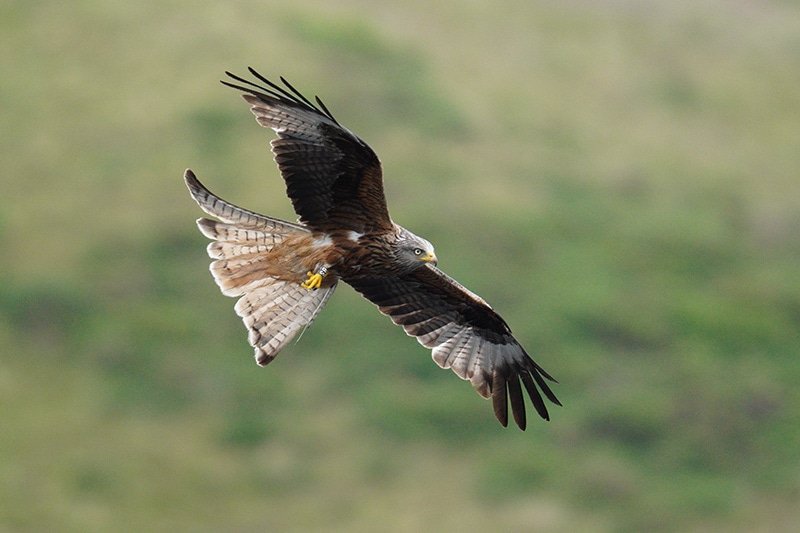
Sony a6400 + 200-600 @ 500mm | 1/1600 | f/6.3 | ISO 1600 | Full Resolution SOOC Download: JPEG | RAW **

Sony a6400 + 200-600 @ 500mm | 1/1600 | f/6.3 | ISO 1600 | Full Resolution SOOC Download: JPEG | RAW **

Sony a7 III + 200-600 @ 600mm | 1/1250 | f/6.3 | ISO 250 | Full Resolution SOOC Download: JPEG | RAW **

Sony a7R III + 200-600 @ 600mm | 1/250 | f/6.3 | ISO 100 | Full Resolution SOOC Download: JPEG | RAW **

Sony a7R III + 200-600 @ 600mm | 1/1600 | f/6.3 | ISO 200 | Full Resolution SOOC Download: JPEG | RAW **

Sony a7III + 200-600 @ 600mm | 1/2000 | f/6.3 | ISO 500 | Cropped | Full Resolution SOOC Download: JPEG | RAW **

Sony a7III + 200-600 @ 600mm | 1/2000 | f/6.3 | ISO 500 | Cropped | Full Resolution SOOC Download: JPEG | RAW **

Sony a7III + 200-600 @ 600mm | 1/2000 | f/6.3 | ISO 500 | Cropped | Full Resolution SOOC Download: JPEG | RAW **
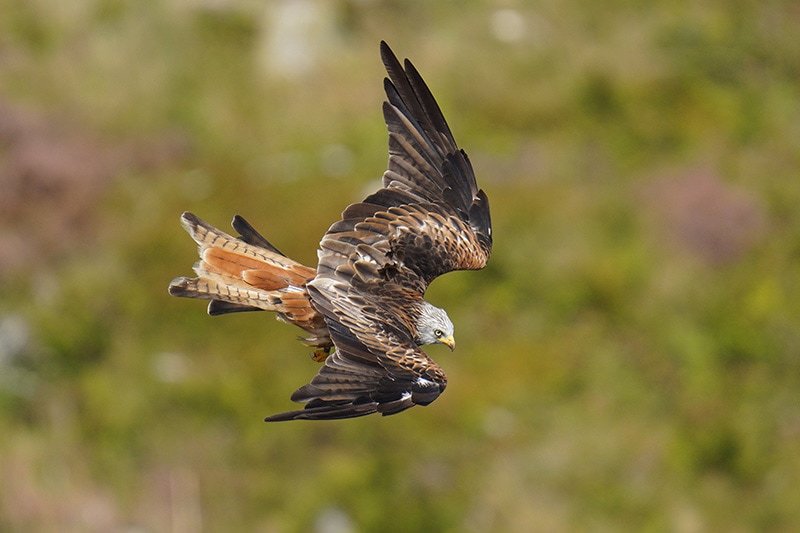
Sony a7III + 200-600 @ 600mm | 1/2000 | f/6.3 | ISO 640 | Cropped | Full Resolution SOOC Download: JPEG
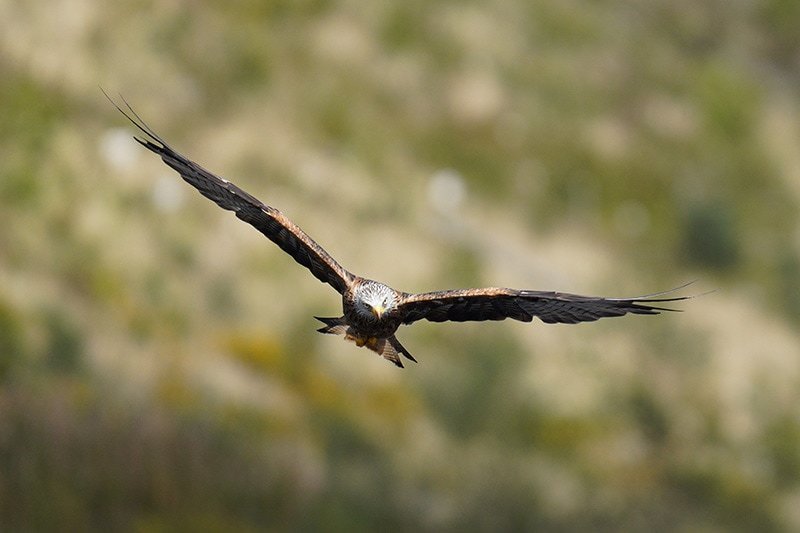
Sony a7III + 200-600 @ 600mm | 1/2000 | f/6.3 | ISO 800 | Cropped | Full Resolution SOOC Download: JPEG | RAW **

Sony a7III + 200-600 @ 600mm | 1/2000 | f/6.3 | ISO 640 | Cropped | Full Resolution SOOC Download: JPEG | RAW **
Sony FE 100-400 Sample Photos
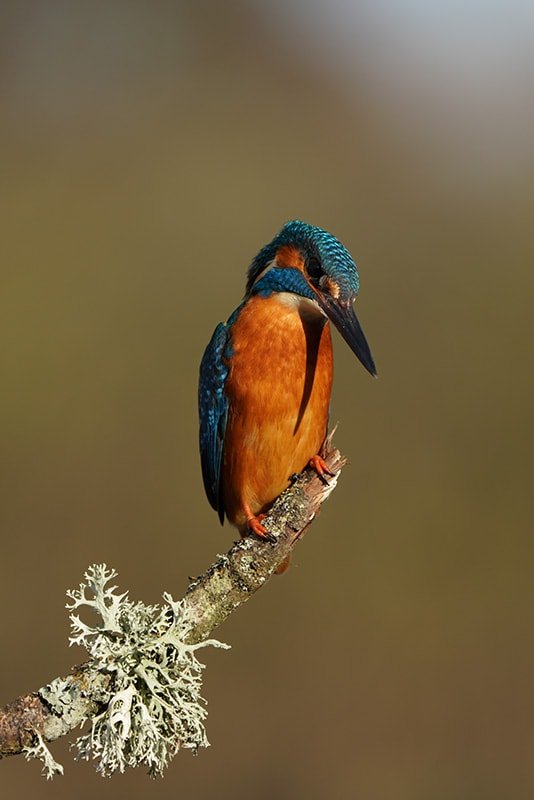
Sony a7R III + 100-400 @ 400mm | 1/400 | f/5.6 | ISO 100 | Full Resolution SOOC Download: JPEG | RAW **
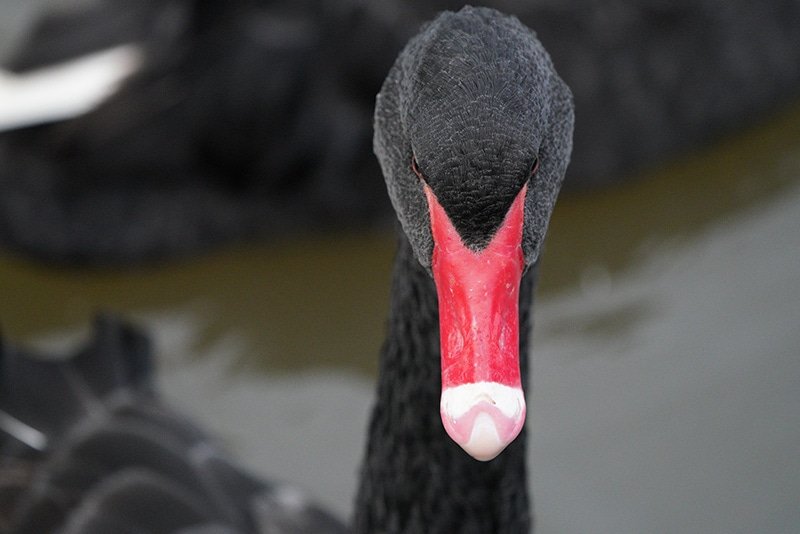
Sony a7R III + 100-400 @ 250mm | 1/1000 | f/5.6 | ISO 8000 | Full Resolution SOOC Download: JPEG | RAW **

Sony a6500 + 100-400 @ 260mm | 1/800 | f/5.6 | ISO 400 | Full Resolution SOOC Download: JPEG | RAW **
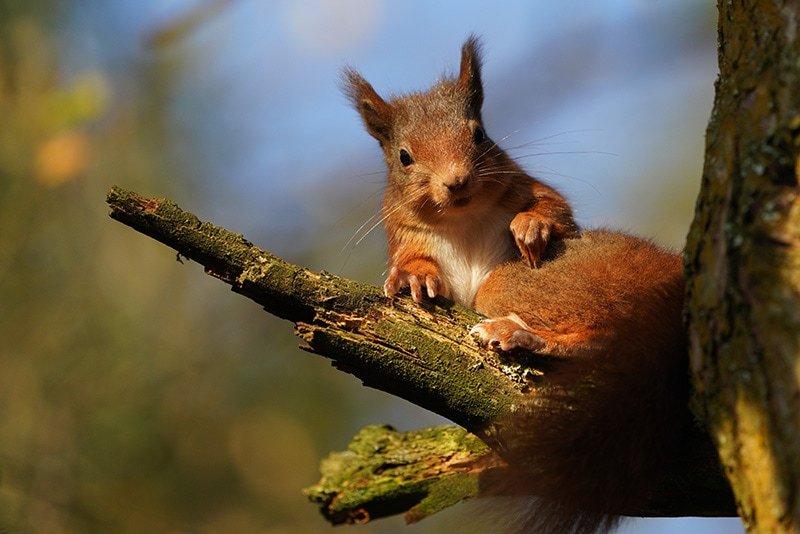
Sony a7R III + 100-400 @ 400mm | 1/800 | f/5.6 | ISO 640 | Full Resolution SOOC Download: JPEG
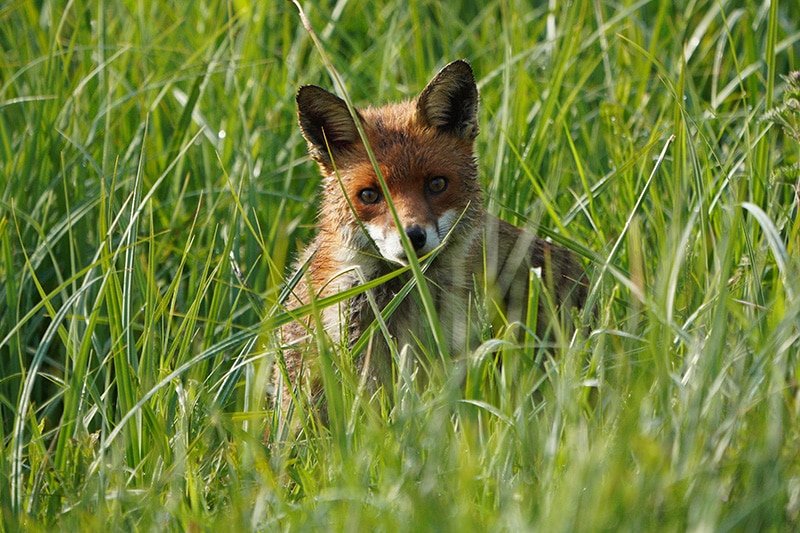
Sony a6400 + 100-400 @ 400mm | 1/1250 | f/5.6 | ISO 800 | Full Resolution SOOC Download: JPEG

Sony a6500 + 100-400 @ 345mm | 1/250 | f/5.6 | ISO 400

Sony a7R III + 100-400 @ 370mm | 1/250 | f/5.6 | ISO 8000 | Full Resolution SOOC Download: JPEG | RAW **

Sony a7R III + 100-400 @ 400mm | 1/250 | f/5.6 | ISO 5000 | Full Resolution SOOC Download: JPEG | RAW **

Sony a7III + 100-400 + 1.4x @ 560mm | 1/2000 | f/8 | ISO 640 | Cropped | Full Resolution SOOC Download: JPEG | RAW **
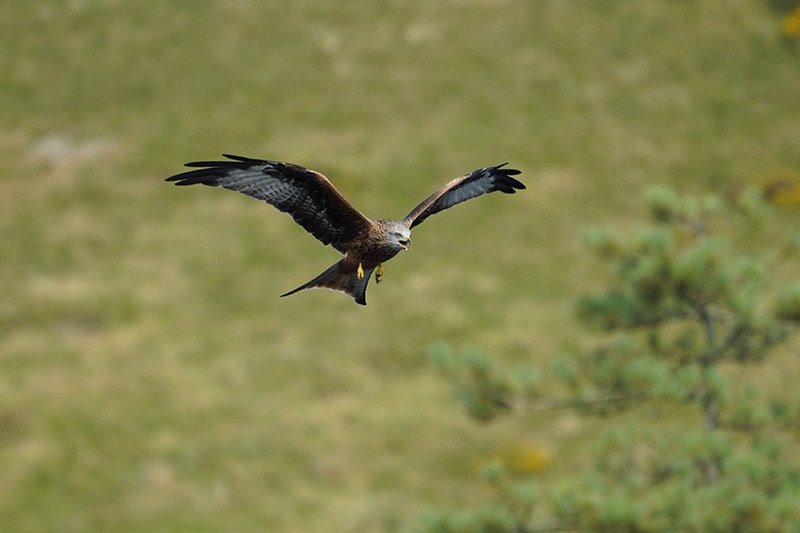
Sony a7III + 100-400 + 1.4x @ 560mm | 1/2000 | f/8 | ISO 2000 | Cropped | Full Resolution SOOC Download: JPEG | RAW **

Sony a7III + 100-400 + 1.4x @ 560mm | 1/2000 | f/8 | ISO 1000 | Cropped | Full Resolution SOOC Download: JPEG | RAW **
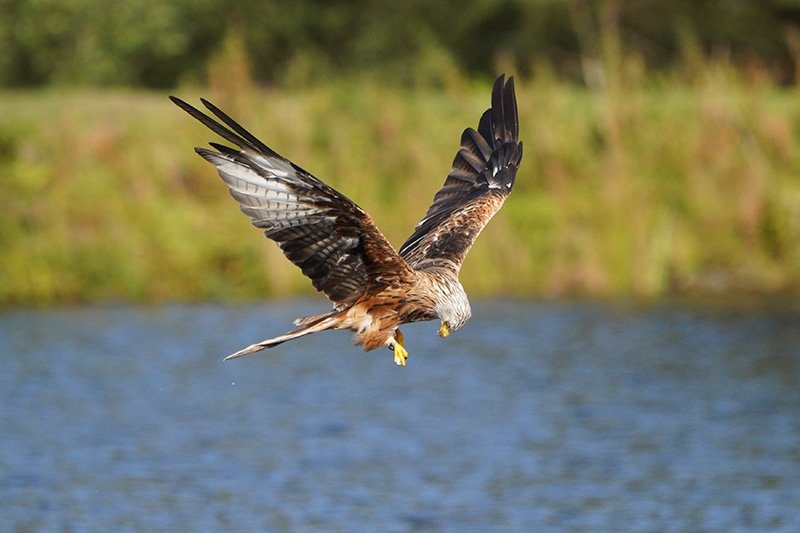
Sony a7III + 100-400 + 1.4x @ 560mm | 1/2000 | f/8 | ISO 2000 | Cropped | Full Resolution SOOC Download: JPEG | RAW **

Sony a7III + 100-400 + 1.4x @ 560mm | 1/2000 | f/8 | ISO 2000 | Cropped | Full Resolution SOOC Download: JPEG | RAW **

Sony a7III + 100-400 + 1.4x @ 560mm | 1/2000 | f/8 | ISO 2000 | Cropped | Full Resolution SOOC Download: JPEG | RAW **
Conclusion
Although there is still much more I’d like to add to this comparison, after owning the 200-600 since it was first released and also the 100-400 since first release I feel comfortable in writing this conclusion.
Both lenses are exceptionally good and although only the 100-400 is badged as a G Master lens, the 200-600 G would certainly not bring any shame to the GM label if Sony had decided to use it.
If you are shooting wildlife then most likely you are going to want as much reach as possible and although you can add the 1.4x teleconverter to take the 100-400 to 560mm / f/8, you will see a noticeable drop in image quality especially compared to the 200-600 at 600mm f/6.3. You’ll also now be shooting at f/8 and will need to crank the ISO a little higher.
If you often shoot using a gimbal then you’ll also find that the 200-600 balances much better since the barrel does not extend when you zoom and throw the balance off. With the 100-400 on a gimbal you’ll either need to fix the zoom and then balance it, or put up with the lens being off balance.
The smooth internal zoom of the 200-600 which features a very short zoom throw also helps to keep your subject in the frame and I find it much quicker to use compared to the 100-400. When you zoom with the 100-400 the weight also changes which affects the balance, and if you are shooting skywards there is also a lot more resistance.
Shooting from a hide with an internal zoom is also beneficial since there is no movement to scare away your subject, whilst zooming in and out with the 100-400 can be risky if your subject doesn’t know that you are there or is very nervous.
The 100-400 is the lightest lens of the two weighing in at 1596g (with tripod foot and hood attached). Without extending the zoom it measures 205mm in length, extending the zoom to 400mm takes it to 285mm. The lens has a maximum diameter of 93.9mm. Adding the 1.4x teleconverter will add an additional 169g in weight and also adds 16mm in length. Without a doubt if you are travelling a lot then this is the lens you will want in your backpack.
The 200-600 weighs in at 2397g (with tripod foot and hood attached), making it a good 800g heavier than the 100-400. It measures 318mm in length with a maximum diameter of 111.5mm. If you are used to shooting with the 100-400 or a lighter lens then you will most definitely feel the weight of the 200-600, especially if you are handholding. But if you are used to the weight of a big prime lens with an SLR camera attached then it will probably feel like a feather to you.
With a minimum focus distance of only 0.98m (3.22 ft) the 100-400 is the best choice for close-up photography, since the 200-600 requires 2.4m (7.88 ft) to autofocus correctly. So if you enjoy shooting butterflies, dragonflies and other bugs then the 100-400 is probably the best lens for you.
The 100-400 does handle chromatic aberration a lot better than the 200-600, it shows no signs of CA in either the center of the frame or towards the edges. The 200-600 shows signs of CA both in the center of the frame and towards the edges where it becomes more pronounced. With lens corrections turned on CA is minimized but still visible, so you may need to apply further CA removal in post if shooting subjects with high contrast. Thankfully I’ve not spotted any CA in the real world images that I’ve shot with the 200-600 so far, but I will certainly be keeping an eye out for this.
If money was no object I would own both of these lenses since they both have their own unique qualities and both are capable of capturing some amazing images. For me personally I now prefer shooting with the 200-600 mainly for the extra reach and internal zooming. My shoulder muscles are just going to have to grow to handle the extra weight!
Whichever lens you choose I don’t think you are going to be disappointed one bit.
Sony 200-600 Bag Guide
If you do decide to go with the Sony FE 200-600 then you might find that your favorite bag is not big enough for this larger lens.
My Sony 200-600 Bag Guide will give you all of the dimensions you’ll need to know to check if your bag is large enough and if not then you’ll also find lots of bag options together with photos of the 200-600 inside.

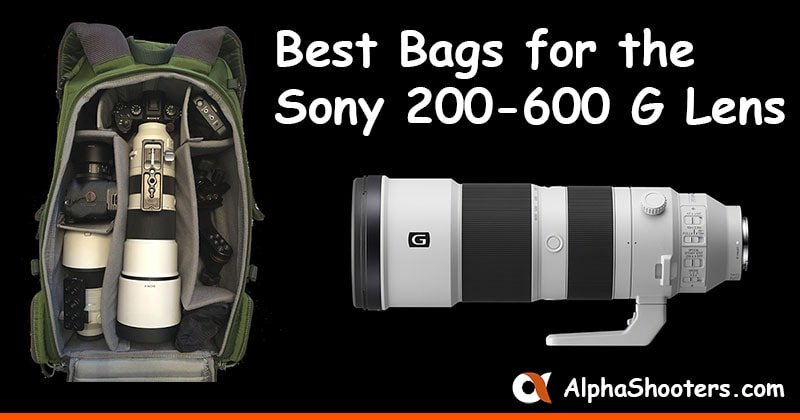

Tim, thanks for this review! Seeing as you have both, what did you find yourself using them for? What made you take the 1-400 out over the 2-600 or vice versa?
Thanks!
Laurence
Hi Laurence. Thanks for commenting here! I’m grabbing the 200-600 most of the time as I’m almost always shooting at 600mm. I’d grad the 100-400 if I wanted to shoot close-ups of small creatures like dragonflies or just wanted to travel as light as possible.
Thanks Rubén. If you want the moon to appear as large as possible compared to your foreground then you’ll achieve this more easily with the 200-600 than the 100-400, you’ll also save some money at the same time! 🙂 You might enjoy this video: https://youtu.be/2xKSOrHm8Zs – Although they were using the new a7S III and the 600mm F4.
Tim, Just like to thank you for all the hard work you put into this review. This is one of the best and detailed reviews I have ever seen-this is the way all lenses reviews should be done and you set the bench mark. I have both of these lenses as well but I keep going to my 200-600mm. Even though I find it heaver and bigger I love the extra focal length compared to using the 100-400 w the 1.4. As noted in your tests I also find it sharper at larger focal lengths vs using the 1.4 multipler. Most importantly thanks for all the test shots as you did all the work for me. IMO Sony should have the G-master designation on this lens from what I see but sure it was a marketing decision with the perception the 100-400 is that much better which it is not in most cases (other than where than extra stop in low light would be a benefit). My only negative is you lose quite a bit of quality when adding the 1.4 multipler but then again its not a prime so probably would not use it in the future. I shoot w a Sony A7R3 and am not a true wildlife photographer so the 200-600 is the perfect lenses plus the price points are incredible. Yes – after this review and my experience I am selling my 100-400. If you just shoot wildlife then get the A9 and a 500 prime. Again, thanks for the great review.
Thank you very much Bob! There are a few more bits I’d like to add but haven’t had much spare time recently, I’ll get there eventually though! Glad to hear that you are enjoying the 200-600 so much as well. I did consider selling my 100-400 as it rarely gets used since I picked up the 200-600, but fortunately I managed to find a few other bits and bobs to sell so that I could keep hold of it for a little longer! 🙂 All the best, Tim
Hi Tim I read part of your article . It’s too late here in Las Vegas so in the morning I will go through it again read it all as it looks interesting . I am a hobbies new to all this but I have a lots of cameras mainly Sony’s and others plus a Sony PXW-FS5M2 and a few good lenses which I have to learn which lens is to what to shoot with I just bought the 2.0x Teleconverter and debating between 100-400GM vs 200-600 I can’t buy both now but need one mainly to use for my camcorder to take videos with . What and which one would you buy if it was you . From reading and watching many You Tube videos I was going towards the 100-400 GM do you recommend this one . Thx
Hi Sam. Both lenses are excellent. I think it comes down to what you are wanting to shoot? As I shoot a lot of wildlife the 200-600 gets me closer so I’m using this a lot more than the 100-400. But if I travelled a lot then the smaller size and lighter weight of the 100-400 would be more appealing. I don’t use the 2.0x teleconverter a great deal as it blocks two stops of light. So on the 100-400 this puts you at f/11 and the 200-600 at f/13 which is rarely ideal and will push up your ISO. Quite a few Sony cameras will lose phase detection at theses higher aperture as well which can really slow down the AF. I’ve never used the Sony PXW-FS5M2 so can’t comment on how either lens will work on this camcorder I’m afraid. All the best, Tim
Thank you Tim , I just purchased the 100-400mm GM lens along with one 1.4 Teleconverter and one 2.0 will test both and keep them in the future I will buy the 200-600mm G since I am trying to sell my a6600 and purchase a Sony Alpha a9 II AS I SAID I AM JUST A beginner hobbies where I tried to find a school in Las Vegas but none all online , I am 71 years old love life married with a one year old Kitten or Cat not sure what to call him at 1 year old .
My library of equipment exceeds $40000.00 so I think that I have to slow down after buying the a9II . I watch many of the videos you posting and others on YouTube so I pick a bit here and there . But it takes me some good time to set any camera I have because I own another 7-8 mostly from Sony’ as soon as I will get the lens next week will let you know how it is going . The shutter count on my a6600 is 330 which is nothing much of use correct ? The a7III that I warned had less than 80 when I sold it but if I buy the a9II this I have to keep as it is an excellent camera from all reviews and videos I watched and read about .
Please stay safe , thanks again for responding .
God Bless you
Sam
Hi Tim,
Thank you for your really detailed review!
At the moment I use a 100-400 with a a6400 crop and a battery grip from MEIKE (bought this setup just some months before they announced the 200-600, as it was the only non-adapted more or less affordable solution then).
I‘m really happy with the overall performance like sharpness and focus speed, and the low weight is just amazing for carrying around.
What I don‘t really like too much is the a6400 body (at least for this purpose) due to missing finger wheel, function buttons, dual card slot…) and the noise due to little bit higher ISO starts to get visible really early.
As I mainly shoot wildlife and I also already own a A7iii, I would be interested in your opinions:
-Would you do the switch from 100-400 to the 200-600, and maybe also sell the a6400?
-Do you think there will be a lot of money loss by trading in a 100-400 or does it make no sense just to have the advantages of the same reach on FF? (100-400 is in a really good condition and only 1 year old, is new more expensive than the 200-600 and there‘s still 1 year of warranty left)?
-According to your experience, would you say that a full frame body with one less step available (wide open ‚only‘ 6.3 with the 200-600 instead 5.6 with the 100-400) could compensate the light loss with a better low light performance than with a crop sensor? I mean, would there be less visible noise even with higher ISO on a full frame compared to aps-c?
It‘s maybe something I would have to test before I decide. Still would really be interesting what you think.
Thank you very much! 🙂
Thanks for commenting Nate. Glad that you liked the review too! 🙂 I understand what you mean about the a6400 body, these are the exact reasons why I don’t use mine so much for wildlife as it gets ergonomically confusing switching between a full-frame and crop body. I mainly use my a6400 for lightweight travel these days. As for your dilemma. I think if I was in your shoes and didn’t really need the a6400 body then I would sell this, and I’d also swap the 100-400 for the 200-600 especially if you are mainly shooting wildlife where you can never get enough reach. This is a heavier lens but I’ve found that I’ve now adjusted to the extra weight. I still have my 100-400 but it’s mainly collecting dust since I picked up the 200-600. I’m not sure what price you would get for the 100-400, which country are you in? There’s only 1/3 of a stop difference between f/5.6 and f/6.3 so this is really nothing to worry about and the a7III definitely has better low light performance than the a6400. If you can rent one for a few days before buying this is always the most sensible choice to help with big decisions! 🙂 All the best, Tim
Hi Tim,
Thank you very much for your answer, it definitely helped me to make a decision.
At the moment I’ve sent my 100-400 for servicing, as I got a big speck of dust behind the front element, don’t know how this could happen. Always handled it really careful and tried to avoid dust as much as possible.
As I wanted to trade in the lens here in Switzerland, they told me the value is just about 1/3 of the price I paid for this new lens one year ago, just because of this clearly visible dust speck, even it’s not visible on the pictures. (Otherwise the lens is in a great condition).
I really hope they will fix it as I still have some supplier warranty left. So the reselling value should be higher again and I’ll try to sell it with the hint, that they had to remove some dust. If the value is still that low, I guess I’ll keep the 100-400 as a second telephoto lens as it is great for close-up shots and really light for travelling. But then I definitely want to go for the 200-600. 🙂
Thank you very much for your support. I wish you all the best,
Nate
Yes dust does always seem to find a way in now and again. I’ve been lucky with mine but generally I’ll only send a lens in to get cleaned if it’s also present in my shots. I’m surprised they knocked off so much for a spec of dust! I hope you are able to get a decent price for it, but keeping hold of it is not a bad thing either! 🙂
Nice review Tim, they are both great lens. I am coming from Canon and now I am using the canon 100-400 ii, sigma 150-600 and sigma 135 1.8 with mc11. The sigma with me-11 is clearly more keeper than the canon lens and I believe the FE200-600 will be much faster and more keepers. I always thought a7iii has better af performance than the a7Riii right? On your Article said a7riii has more keeper rate than the a7iii. I am currently using A9 and a7Riii. Is a7r4 worth the upgrade? Thanks
Thanks Samuel. The native lenses are generally faster and more reliable when it comes to AF performance than none native lenses, although the MC-11 does do a fantastic job. In my AF tests with Frank the a7III had a keeper rate of 87% vs 85% from the a7R III, so just slightly higher. You won’t see much of an improvement with AF performance between the a7R III and the IV, so it’s not worth upgrading if you already have the a9 and a7R III. I’d say it’s only really worth upgrading if you would find the extra megapixels useful or have money burning a hole in your pocket! 🙂
Great review! Definitely leaning towards that 200-400 nor more than ever. Thank you!
Thank you very much BenGie. Both are great lenses!
Good review, thank you. In the sharpness tests I found from your JPEGS that the 100-400 was consistently sharper – compare the hairs above Manny’s nose. But once the 1.4TC is added to the 100-400 it consistently falls behind the 200-600 in sharpness, which is kind what I expect from a TC. Keep up the good work.
Glad you found the review helpful Jack! It is a very close call between the two at 400mm. The TC definitely has a larger impact, but if you don’t crop in too much and pixel peep it’s not a big worry, I still use it. Thanks for dropping by! 🙂 Tim
Excelente y muy completa la comparación, gracias por compartir tu esfuerzo a tantas pruebas… Actualmente soy Canon Mark IV 5D, pero en 2 semanas compraré la 7 III o 7 R III , aun no me decido y los siguientes lentes: FE 85 1.8, Sony Vario Tessar 16-35, FE 70-200 2.8 y el FE 200-600. Estoy muy emocionado.
Muchas gracias Cesar!
Thank you for this detailed comparison.
I spent hours reading reviews but you answered all my questions.
Bravo
Very glad to hear that it helped you out! 🙂
This is a fantastic review! I am still in debate between the two options but I may be getting close to a decision. I am a beginner photographer and I am looking for the best bang for my buck right now. I am a hiking guide in Denali National Park and I want to get some really awesome wildlife shots this year. Though I would be backpacking most of the time I have never been an ultra light packer so I am not afraid to add the weight if it means better quality. I just might go for the 200-600…
Thank you very much Pika. If you have the option to hire both or try both out at a local store then this will definitely give you a better idea. I’d personally prefer the 100-400 for backpacking but now I’ve had the 200-600 for a while I don’t notice the weight so much as when I first had it. Although when I pick up my 100-400 now it feels like a feather in comparison 🙂
Hi Tim, great review. I have recently changed from Canon to Sony and am looking to change over my Canon 100-400, which in my opinion is a beautiful lens. The 200-600 Sony lens is an attractive option and I’ll have to seriously consider it. Meanwhile I will plod along with my Canon lens with a Metabones V converter. Cheers. Fraser
Thank you Fraser. Many are using Canon glass with Metabones and the MC-11 adapter. You don’t get quite the same AF performance as native glass but it certainly does a good enough job for all but the very fastest of action shots. Might be worth hiring the 200-600 sometime to see how you get on. Tim
Timothy, I greatly appreciate the effort and expertise that went into these comparisons. You’ve answered so many of my questions having just switched from Canon to the aR7IV along with a 200-600. Thank you!
Thanks Al. Glad to hear that you found the article helpful. I really hope you enjoy shooting with your new setup!
Excellent review and most helpful!
Many thanks Steve!
Thank you Greg. I’m a beginner at photography & I’ve just bought a Sony Alpha R iii, upgrading from the A 6000, which I took on a recent trip to Costa Rica with a 24-240mm walk around lens and a good book on photography (you’ll probably horrified at this thought, what a rookie!!). The biggest challenge I found was handling low light situations and getting to grips with coming off auto. I bought back some great shots, even of humming birds, but have come back enthused about investing in a good wildlife lens, that will give me more reach and better quality shots, for my next trip to India (hopefully to see some tigers). I was pretty settled on the 100-400 but thought I’d do some more digging and found the 200-600mm & your review. What dilemma!! My biggest concern is the extra weight, being female & I love travelling so need have other stuff in my rucksack; the 24-240mm at 800g, was a big step up for me! Plus I’m a beekeeper and I love shooting bees and a tripod isn’t an option. The final clinch was the F stop both lenses use (rainforests can be low light and animals love hiding in vegetation). So, I’ve decided to go for the 100-400mm. Your review was fantastic, thank you & has helped make my decision. Put I learnt loads from your post. I just hope Sony don’t launch a new ultra-lightweight lens in this category soon…!
Hi Elaine, a trip to Costa Rica sounds fantastic, I’d love to go myself one day. The best way to learn is definitely by throwing yourself in the deep end 🙂 If you are under the forest canopy then it is always going to be a challenge with low light unfortunately. I think for your travels you’ve made the right choice with the 100-400 as it will pack smaller and saves you some valuable grams. Also if you enjoying shooting your bees you’ll get much better close up shots with the 100-400 due to the smaller minimum focus distance. You can also add the 1.4x teleconverter if you need a little extra reach at some point. I don’t think you need to worry about a super light telephoto coming out anytime soon! 🙂 Hope you have an amazing time in India!